Marion Baruch
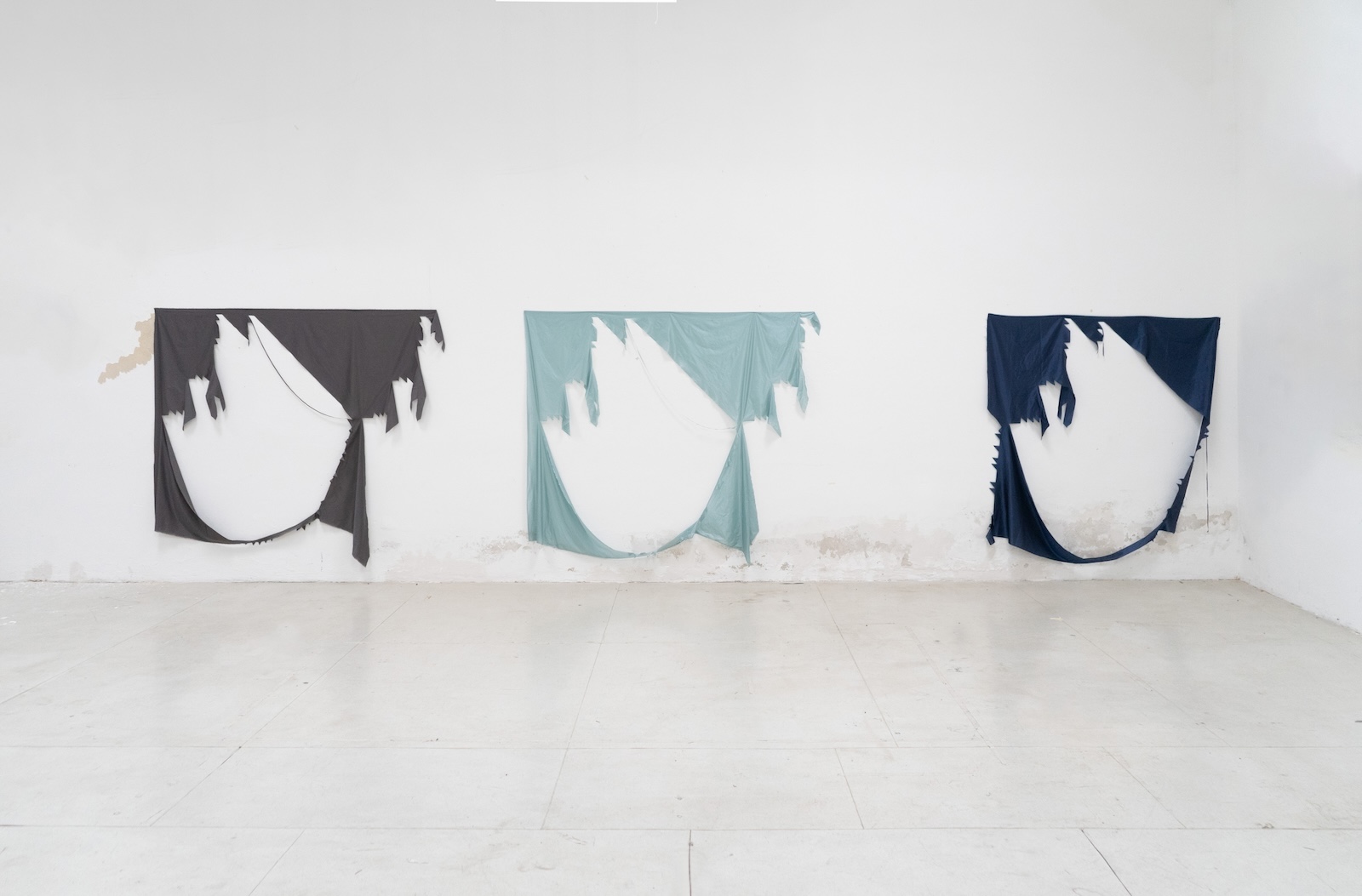
170 x 700 cm (triptych)

330 × 146 cm
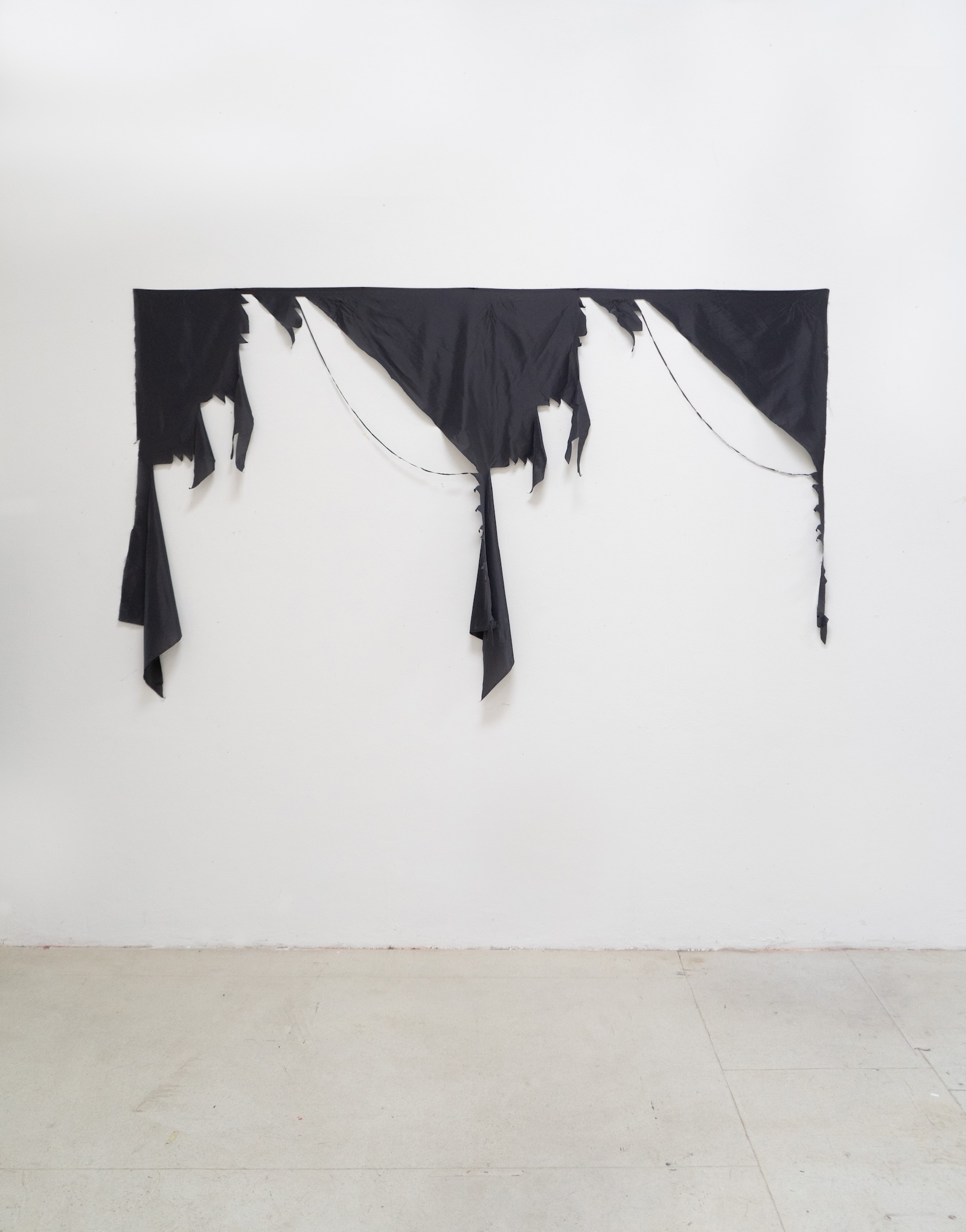
166 × 277 cm

295 × 149 cm

120 x 128 cm
When Marion Baruch found the fabric remnants that would become Ponte-Cattedrale, she immediately thought of a hybrid structure between a cathedral and a bridge. By connecting these two elements, the artist produces a parallel between the random shapes of the textile and architecture. In this way, she emphasizes on the fact that both are reminiscent of human-sized constructions. Like the Surrealists, she humorously conceives a composite architecture that calls for a poetic and imaginary world.

80,5 x 94,5 cm
After a long period practicing conceptual then relational art, Marion Baruch encountered physical difficulties linked to her advanced age. Hence, she operated a major turning point in her career at the end of the 2000s. She returns toward formal art, and discovers the pictorial potential of fabric remnants she collects from the textile industry. In this new artistic cycle, her first move is to link her work on these materials fated to oblivion with the great master of modern art who influenced her. Marion Baruch thus starts to name her artwork by dedicating them to artists she loves or she has loved, like spontaneous and free quotations to art history.
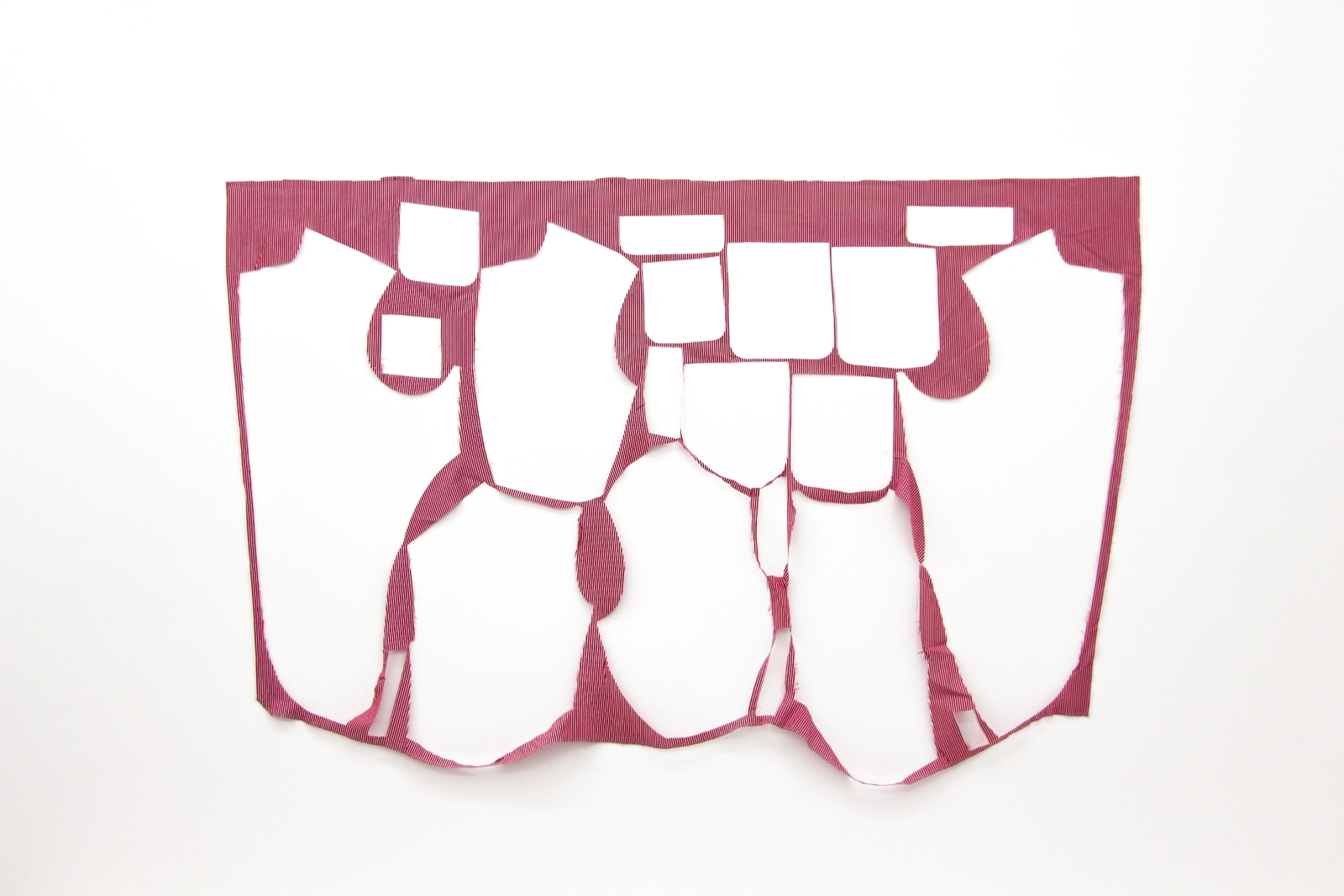
100 x 154 cm
Since the end of the 2000s, Marion Baruch has made a major artistic shift by taking an interest in left-overs of fabric from the textile industry. From this material, she has created artworks that are both sculptures and pictorial compositions. She notably emphasizes on the way the fabric reconstructs the space when it is hung. At the beginning of this new artistic cycle, she conceived her artworks by spontaneously quoting art history, from painting to more conceptual works. Le paysage n'est nulle part is an ironic nod to classical paintings. Marion Baruch uses its traditional horizontal format although there is nothing narrative about it. It is only a poetic reference.

49 x 42 cm
Marion Baruch has, for the past ten years, been intervening on fabric offcuts retrieved from the textile industry in Milan. The artist selects, sorts and arrange those materials, so as to transform those disregarded scraps from the industrial and urban society into forms characterised by a flexible geometry. Hung from the ceiling or pinned on the wall, her works reflect a history, as social and political as individual and sensitive.

297 x 154 cm
Marion Baruch has, for the past ten years, been intervening on fabric offcuts retrieved from the textile industry in Milan. The artist selects, sorts and arrange those materials, so as to transform those disregarded scraps from the industrial and urban society into forms characterised by a flexible geometry. Hung from the ceiling or pinned on the wall, her works reflect a history, as social and political as individual and sensitive.

4 parts - 300 x 320 cm (approximatly) various dimensions
©Noah Stolz
Flowers remain a very rare subject in Marion Baruch's work because she does not particularly like their bucolic pattern. Originally, La vitesse des fleurs was supposed to depict kites. However, the artist was not convinced by this idea. When she hung them on the wall, she discovered that these shapes behaved like flowers with an ephemeral and ethereal aspect. The title accentuates the fleeting aspect of these plants, by including the notions of fragility and life, growth and evolution.
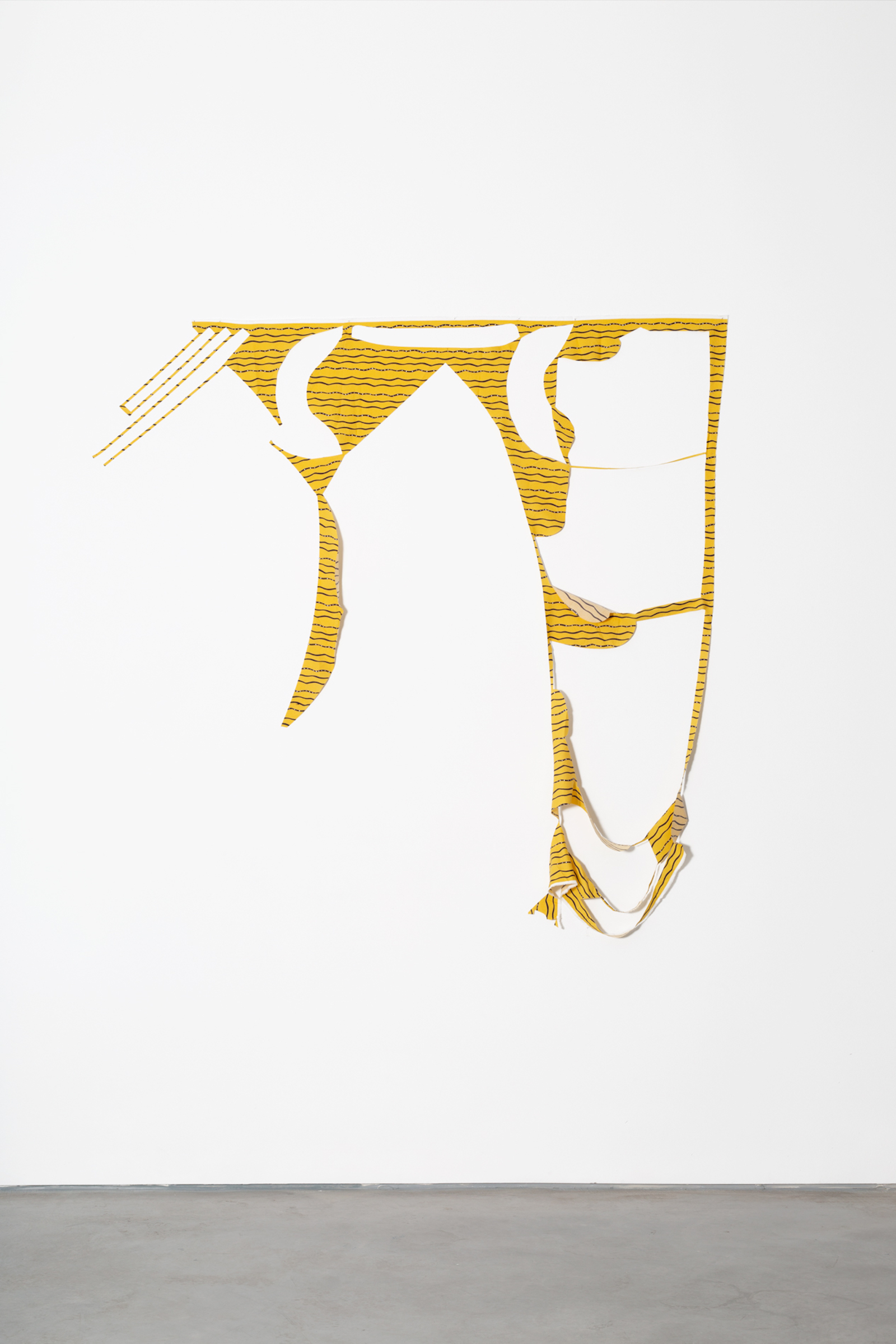
165 x 155 cm
©Margot Montigny
Marion Baruch has, since the end of the 2000s, been intervening on fabric offcuts retrieved from the textile industry in Milan. The artist selects, sorts and arrange those materials, so as to transform those disregarded scraps from the industrial and urban society into forms characterised by a flexible geometry. Hung from the ceiling or pinned on the wall, her works reflect a history, as social and political as individual and sensitive.

207 × 175 cm
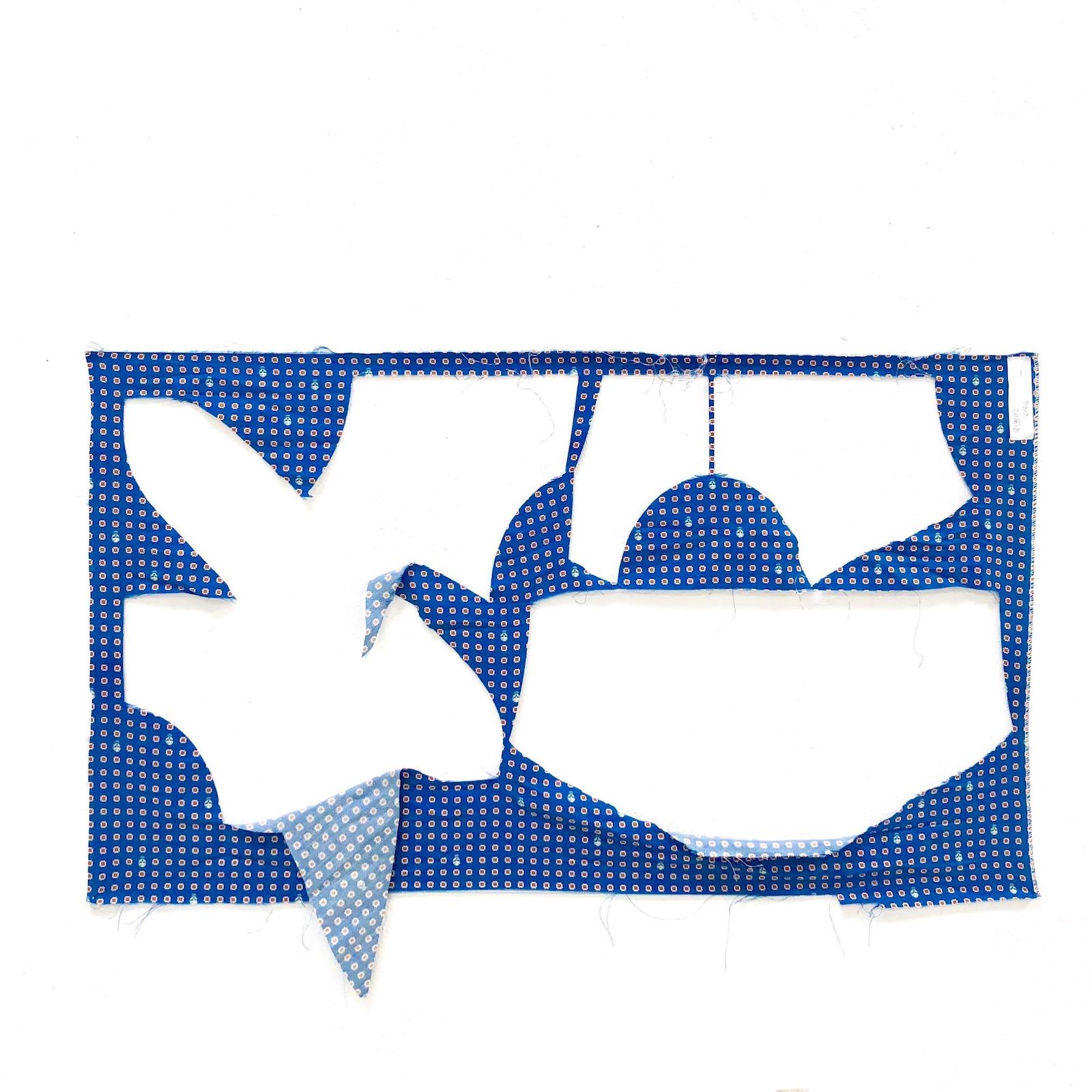
51 x 87 cm
Marion Baruch has, for the past ten years, been intervening on fabric scraps retrieved from the textile industry in Milan. The artist selects, sorts and arrange those materials, so as to transform those disregarded scraps from the industrial and urban society into forms characterised by a flexible geometry. Hung from the ceiling or pinned on the wall, her works reflect a history, as social and political as individual and sensitive.

60 x 117 cm
© Noah Stolz
Marion Baruch has, for the past ten years, been intervening on fabric offcuts retrieved from the textile industry in Milan. The artist selects, sorts and arrange those materials, so as to transform those disregarded scraps from the industrial and urban society into forms characterised by a flexible geometry. Hung from the ceiling or pinned on the wall, her works reflect a history, as social and political as individual and sensitive.

160 x 162 cm
Noah Stolz
Marion Baruch has, for the past ten years, been intervening on fabric offcuts retrieved from the textile industry in Milan. The artist selects, sorts and arrange those materials, so as to transform those disregarded scraps from the industrial and urban society into forms characterised by a flexible geometry. Hung from the ceiling or pinned on the wall, her works reflect a history, as social and political as individual and sensitive.
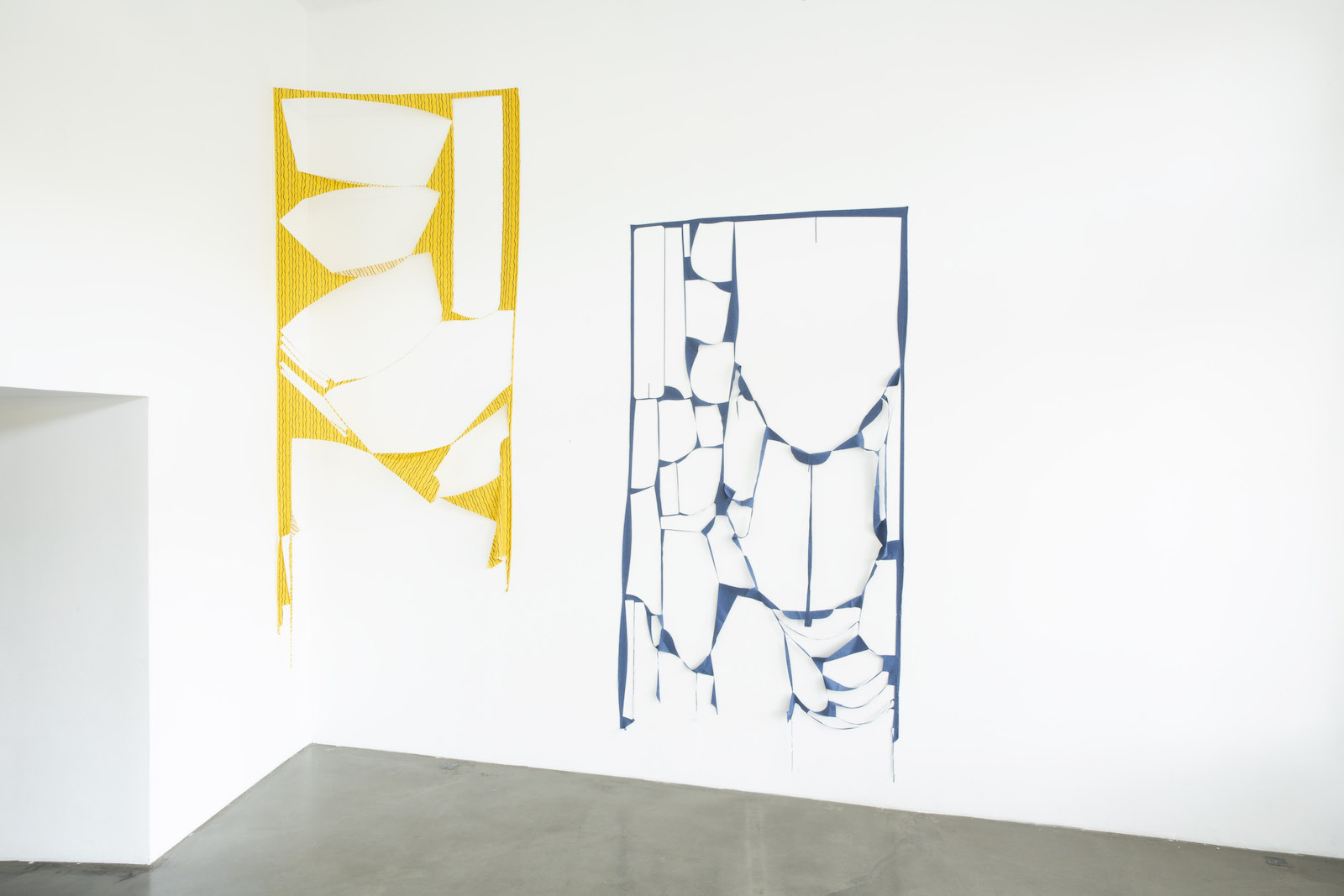
335 x 136 cm
On the left of the photograph
Noah Stolz
Marion Baruch has, for the past ten years, been intervening on fabric offcuts retrieved from the textile industry in Milan. The artist selects, sorts and arrange those materials, so as to transform those disregarded scraps from the industrial and urban society into forms characterised by a flexible geometry. Hung from the ceiling or pinned on the wall, her works reflect a history, as social and political as individual and sensitive.

77 x 29 cm
Since the 2010s, Marion Baruch has produced artworks from fabric remnants collected in the Italian textile industry. They become sculptures as well as pictorial compositions. She selects forms and materials, and works on the way the fabric occupies and reconstructs the space. Literally meaning "the self-confident little ones", I piccoli sicuri di sé is an art piece that did not resonate with her at first. Nevertheless, the more she observed it, she grew attracted to its shape and small size. It inspired her this title, as she could not resist the self-confidence the artwork brought out.
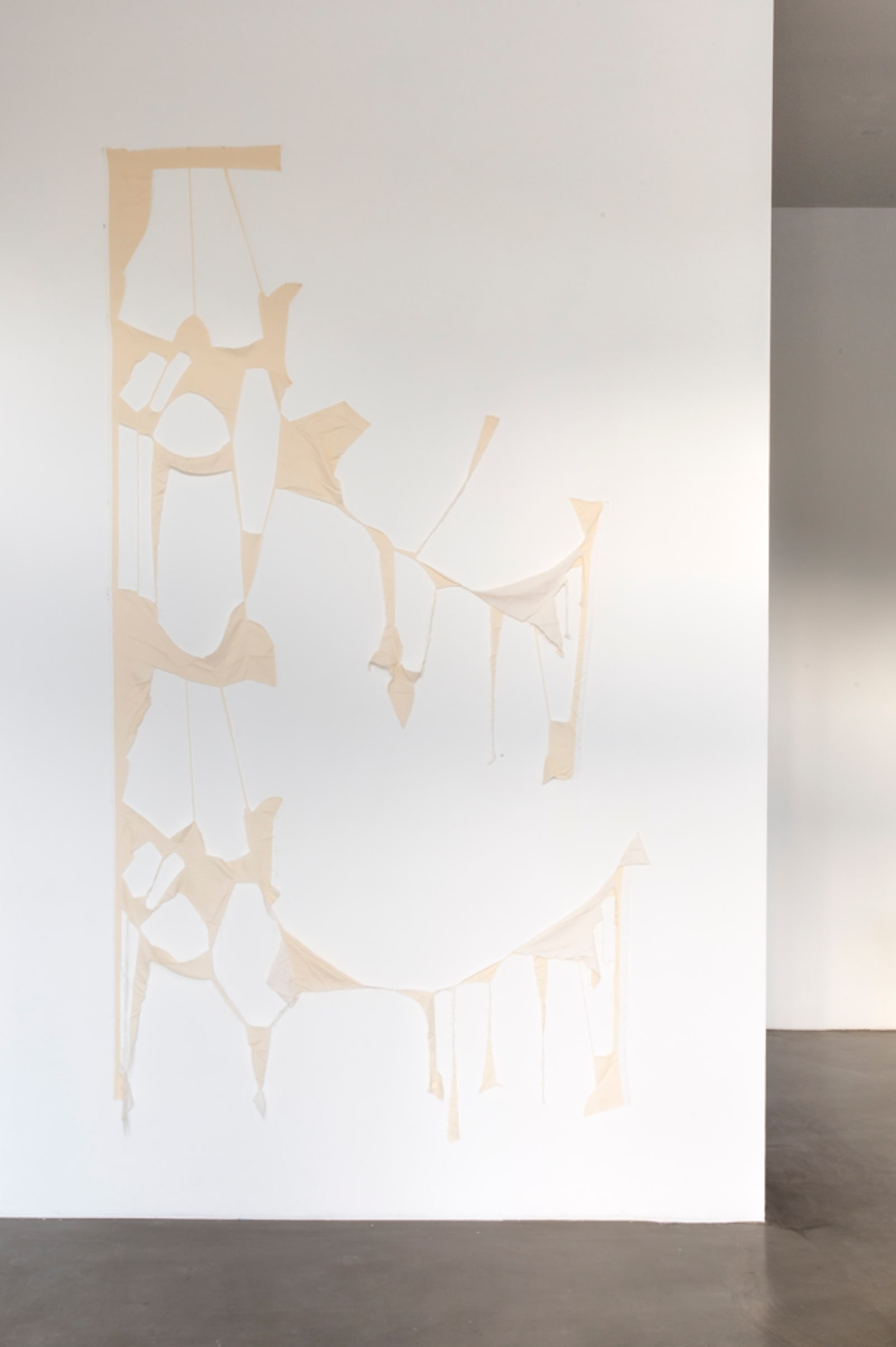
330 x 183 cm
crédit Noah Stolz
Marion Baruch has, for the past ten years, been intervening on fabric offcuts retrieved from the textile industry in Milan. The artist selects, sorts and arrange those materials, so as to transform those disregarded scraps from the industrial and urban society into forms characterised by a flexible geometry. Hung from the ceiling or pinned on the wall, her works reflect a history, as social and political as individual and sensitive.
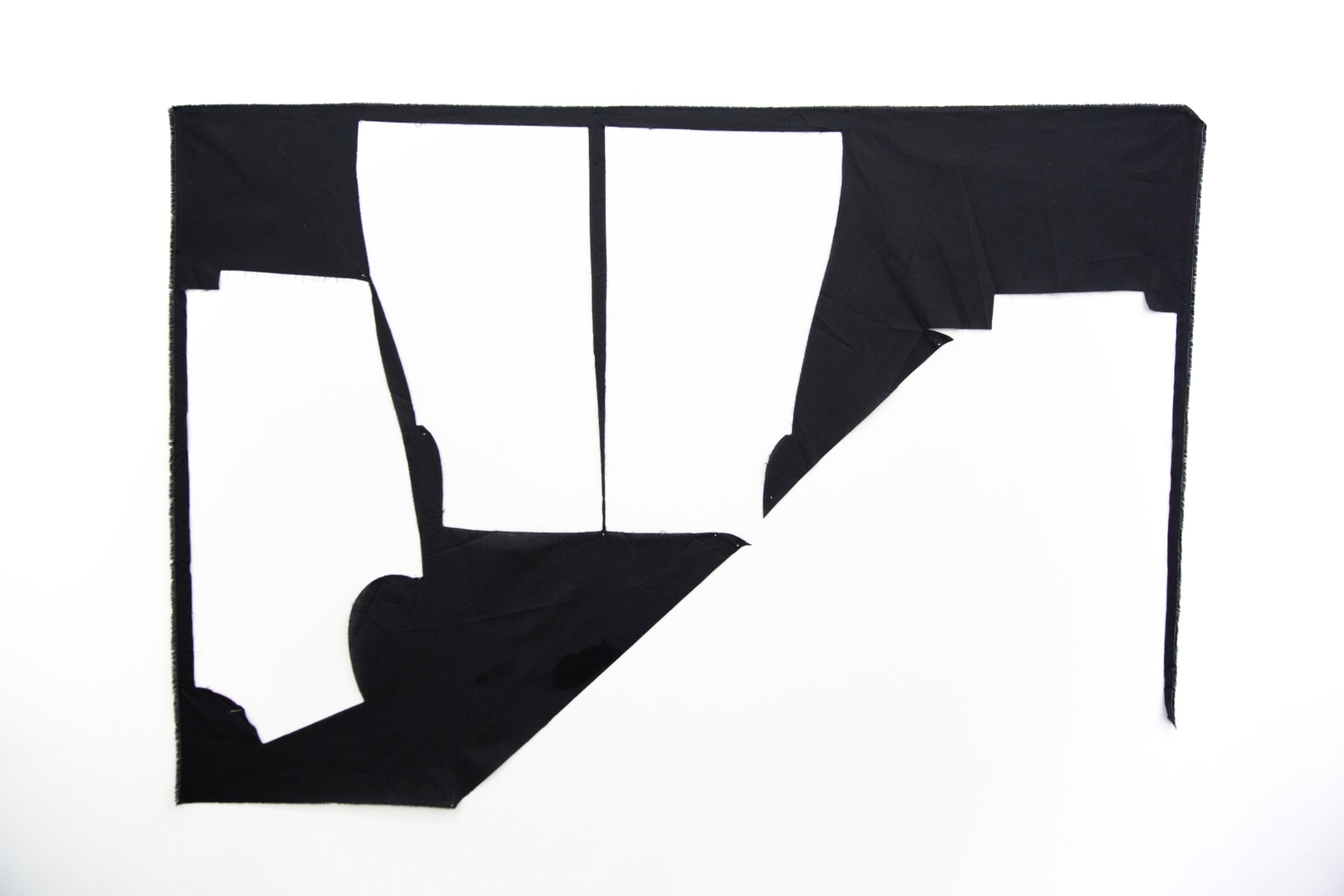
100 x 146,5 cm
Marion Baruch has been suffering from a sight-damaging disease since the 2000s. This physical constraint leads her to apprehend her artworks as a whole without really focusing on the details. She is interested in the general impression she has of the shapes generated by the passage of the textile industry on the fabric. She deciphers, invents and transcribes this particular language related to our society. The variations in the drawings, particularly the opposition between the frame and the cut-outs fascinate the artist who creates works that become sculptures as well as pictorial compositions.

79,5 x 155 cm
Codes and language are very central to Marion Baruch's work. The scraps of fabric she uses to create her works are themselves a form of language that prints the body, but also reflects the productive and industrial society. Numérologie is part of a series named "variation" and refers to a set of beliefs that attributes characteristics to numbers, making interpretations vary according to the context. These minor variations interest the artist in her work. The seemingly regular patterns actually constitute a set of oscillations that dance differently depending on the space in which the work is hung. Chance is thus at the centre of the variation mechanism, producing a slightly different work each time it is shown.

169 x 138 cm
Cristalli di carta is part of the series named Citta di carta, literally translated as "paper town". When Marion Baruch found this left-over of white fabric, she imagined a map of a city. The represented area looked ephemeral and fragile like paper, because of its delicate shapes. The title, in addition to evoking her subject, refers to a process in geography that consists of adding a fictitious city to a map to protect it from plagiarism. In this way, Cristalli di carta materially represents an imaginary and ephemeral city and creates a link between the remnants of fabric and a chimerical space fantasized by the artist.

550 cm x 330 cm
Marion Baruch has, for the past ten years, been intervening on fabric offcuts retrieved from the textile industry in Milan. The artist selects, sorts and arrange those materials, so as to transform those disregarded scraps from the industrial and urban society into forms characterised by a flexible geometry. Hung from the ceiling or pinned on the wall, her works reflect a history, as social and political as individual and sensitive.
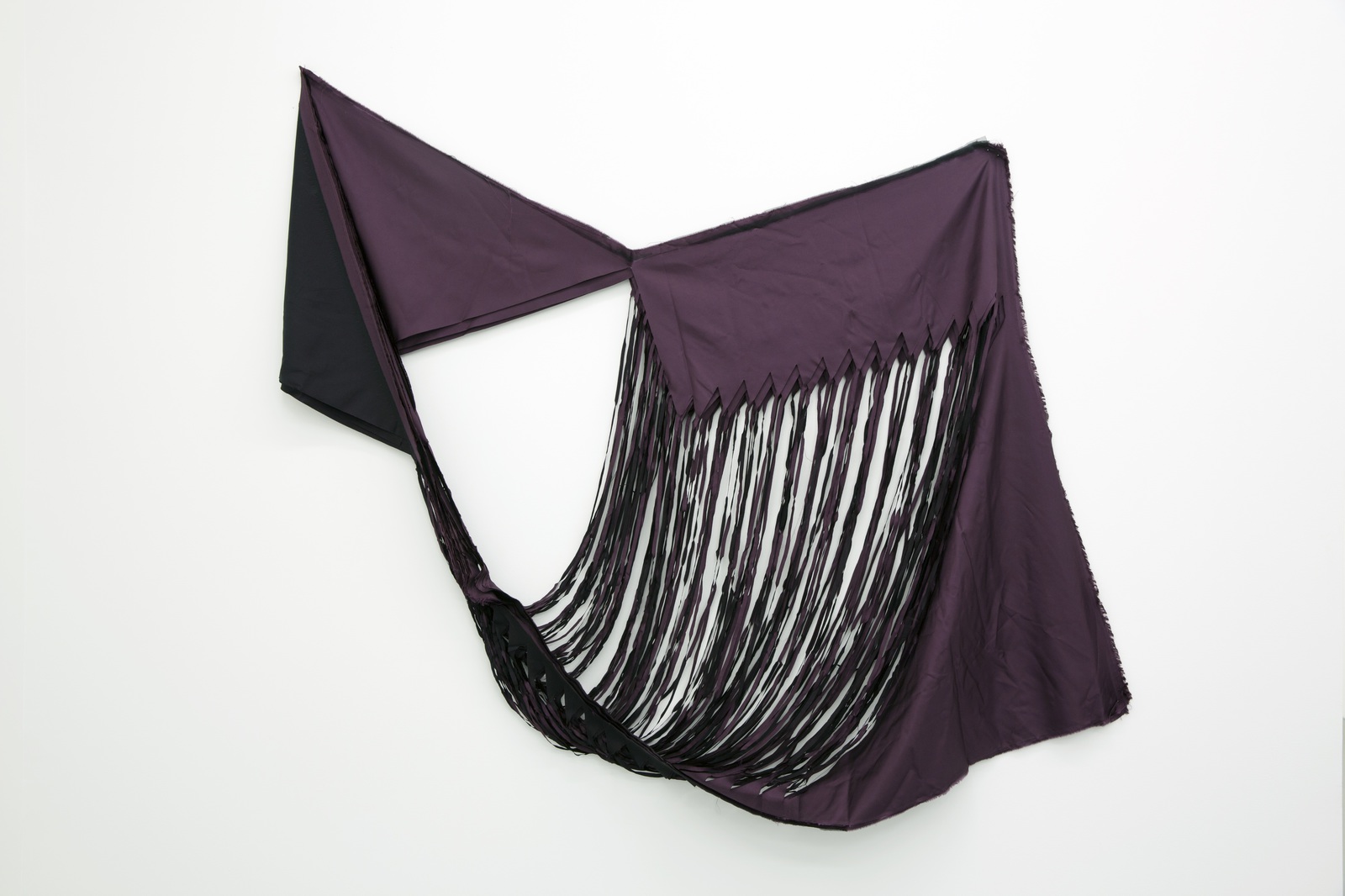
140 x 107 cm
Marion Baruch has, for the past ten years, been intervening on fabric offcuts retrieved from the textile industry in Milan. The artist selects, sorts and arrange those materials, so as to transform those disregarded scraps from the industrial and urban society into forms characterised by a flexible geometry. Hung from the ceiling or pinned on the wall, her works reflect a history, as social and political as individual and sensitive.
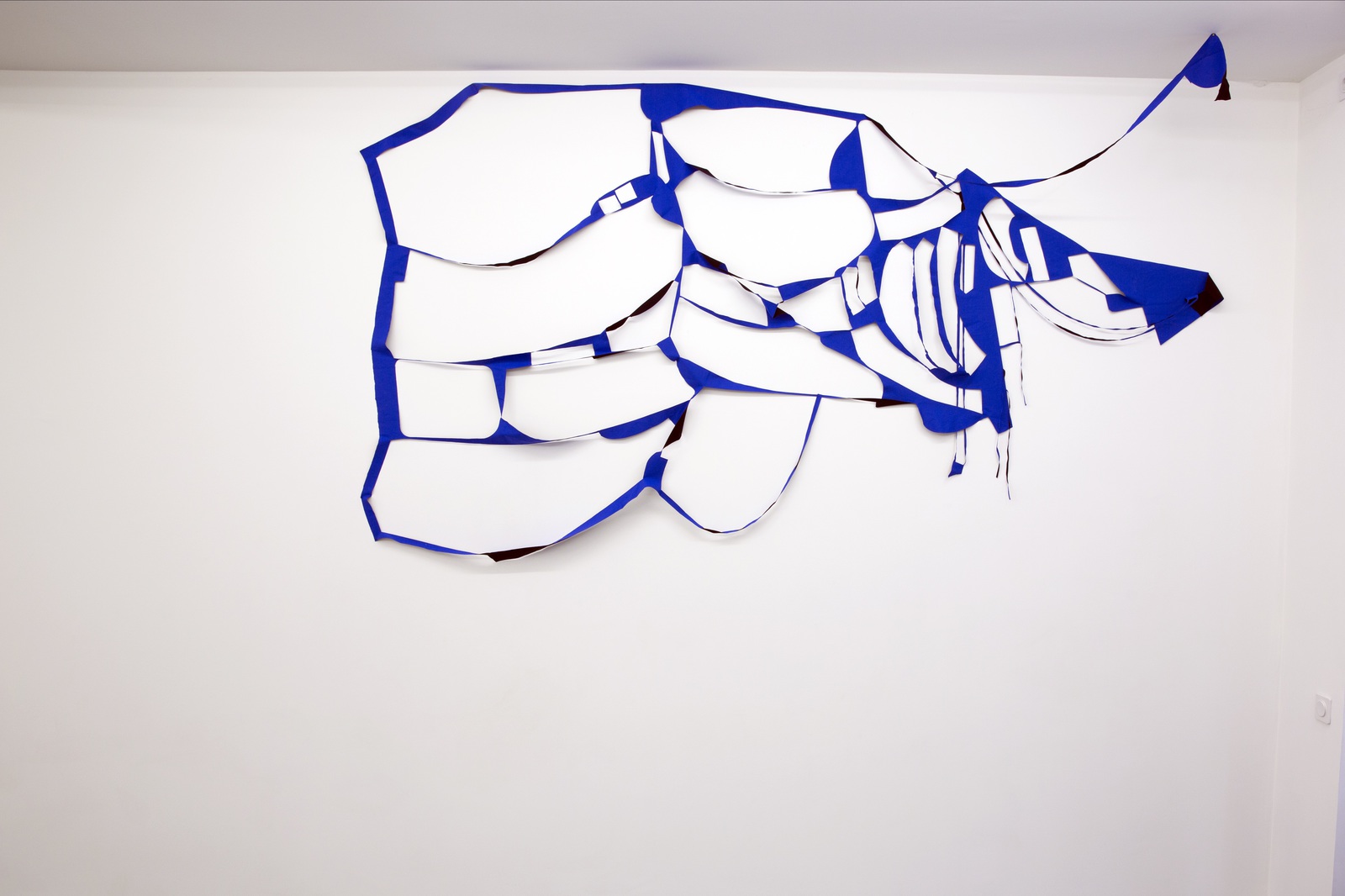
Double-faced synthetic fabric
175 x 286 cm
Marion Baruch has, for the past ten years, been intervening on fabric offcuts retrieved from the textile industry in Milan. The artist selects, sorts and arrange those materials, so as to transform those disregarded scraps from the industrial and urban society into forms characterised by a flexible geometry. Hung from the ceiling or pinned on the wall, her works reflect a history, as social and political as individual and sensitive.
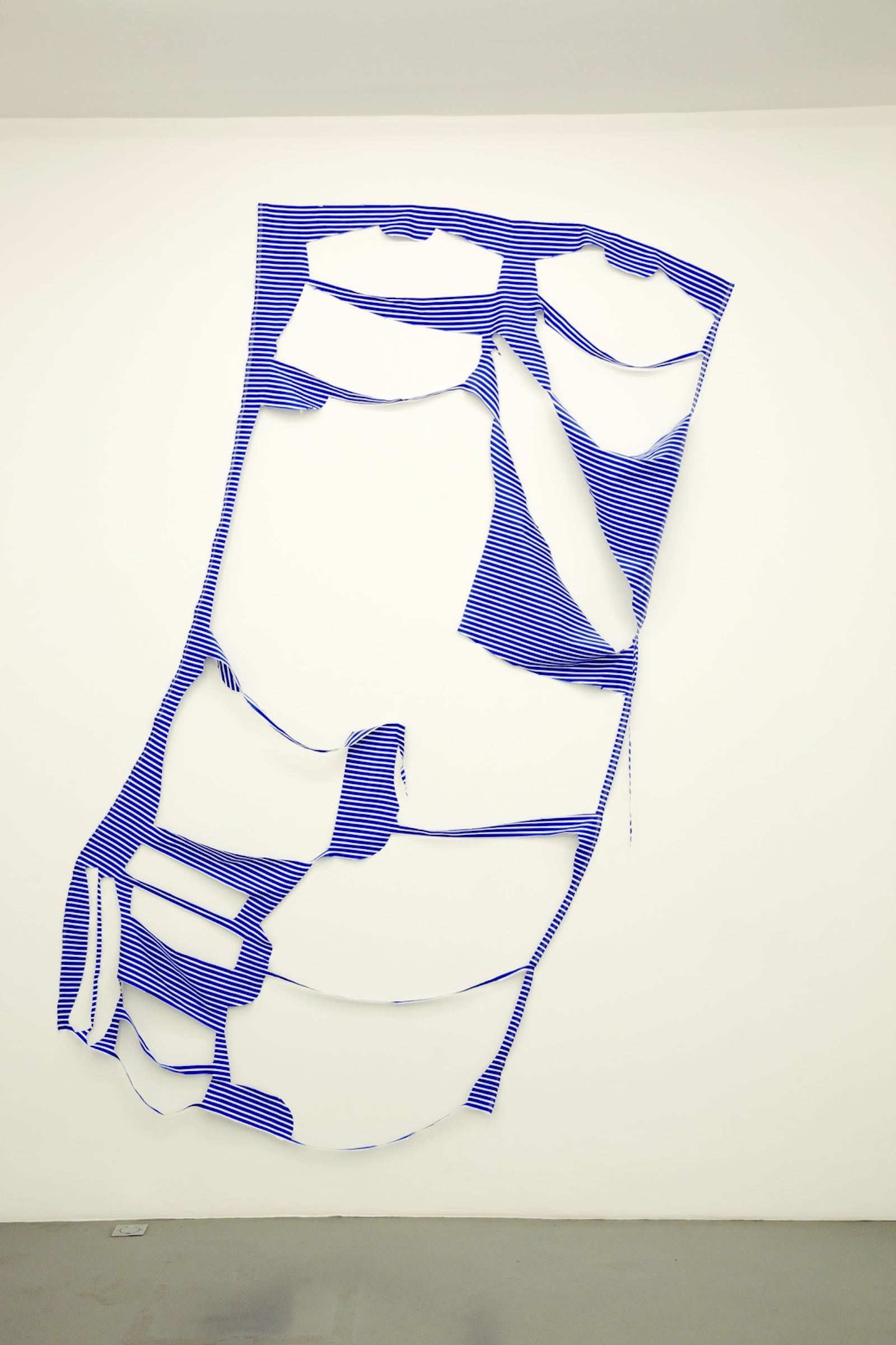
Cotton
258 x 206 cm
Marion Baruch has, for the past ten years, been intervening on fabric offcuts retrieved from the textile industry in Milan. The artist selects, sorts and arrange those materials, so as to transform those disregarded scraps from the industrial and urban society into forms characterised by a flexible geometry. Hung from the ceiling or pinned on the wall, her works reflect a history, as social and political as individual and sensitive.
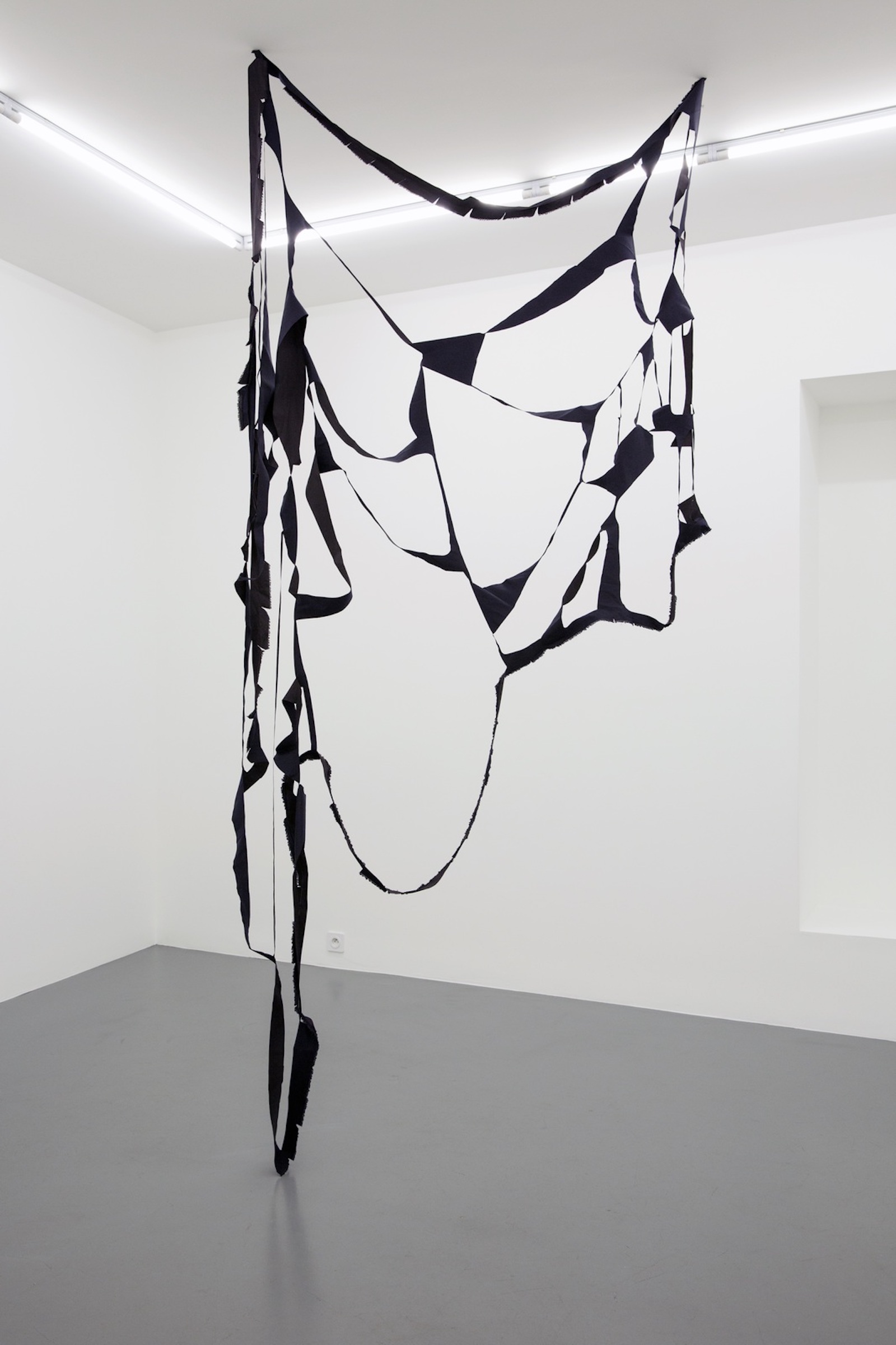
355 x 155 cm
Marion Baruch has, for the past ten years, been intervening on fabric offcuts retrieved from the textile industry in Milan. The artist selects, sorts and arrange those materials, so as to transform those disregarded scraps from the industrial and urban society into forms characterised by a flexible geometry. Hung from the ceiling or pinned on the wall, her works reflect a history, as social and political as individual and sensitive.

Silk
145 x 145 cm
Marion Baruch has, for the past ten years, been intervening on fabric offcuts retrieved from the textile industry in Milan. The artist selects, sorts and arrange those materials, so as to transform those disregarded scraps from the industrial and urban society into forms characterised by a flexible geometry. Hung from the ceiling or pinned on the wall, her works reflect a history, as social and political as individual and sensitive.

33 x 135 cm
Mon chat, lui, échappe à toute sorte de classification is an artwork which looks like a cat. The latter is represented in the Cubist's way, as the paws and other elements composing its shape are recognisable. Representing at the same time an abstract pictorial composition and a sculpture, this work is filled with a dose of humour which characterizes the artist and points out the unclassifiable aspect of her art.
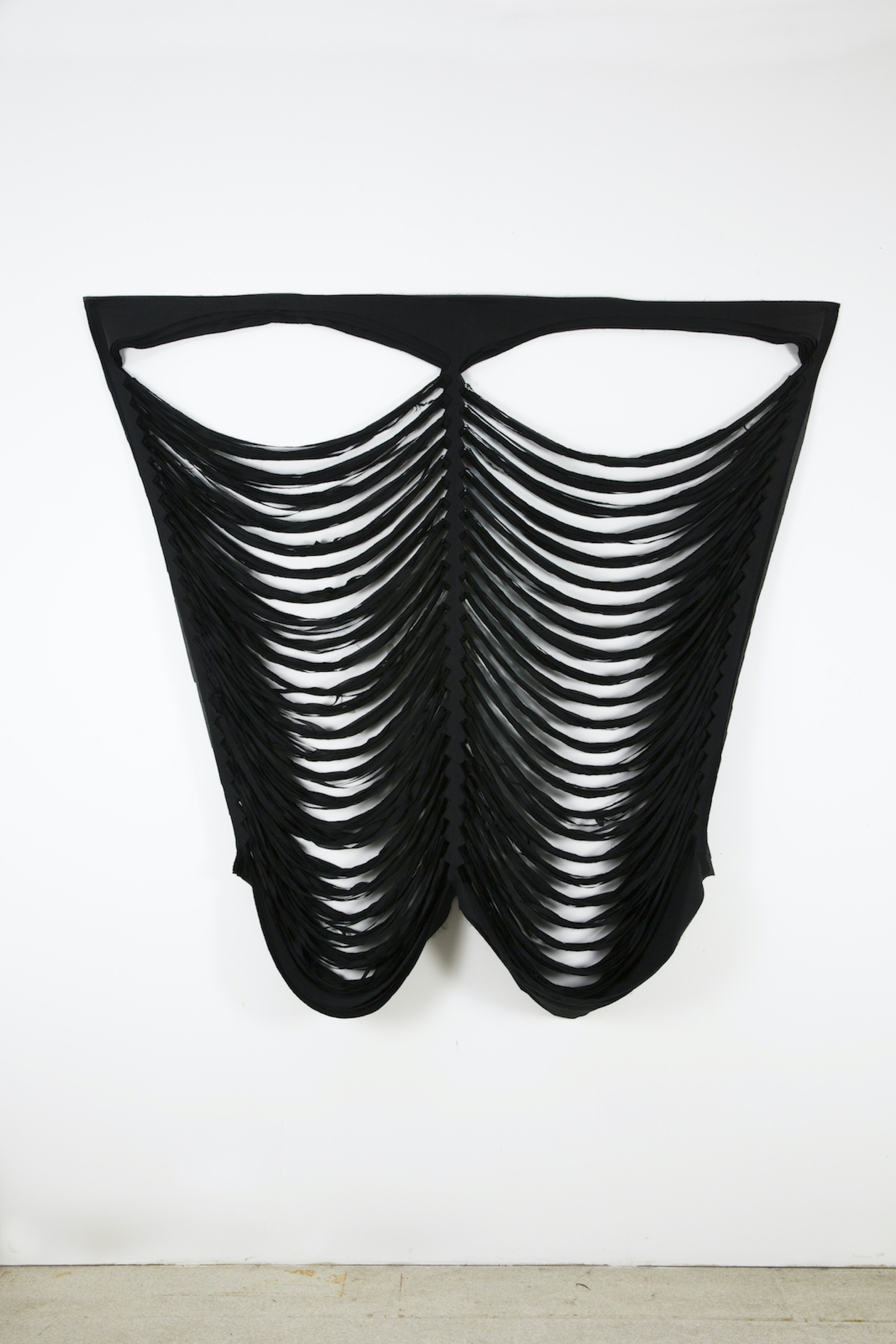
185 x 200 cm
Marion Baruch has, for the past ten years, been intervening on fabric offcuts retrieved from the textile industry in Milan. The artist selects, sorts and arrange those materials, so as to transform those disregarded scraps from the industrial and urban society into forms characterised by a flexible geometry. Hung from the ceiling or pinned on the wall, her works reflect a history, as social and political as individual and sensitive.
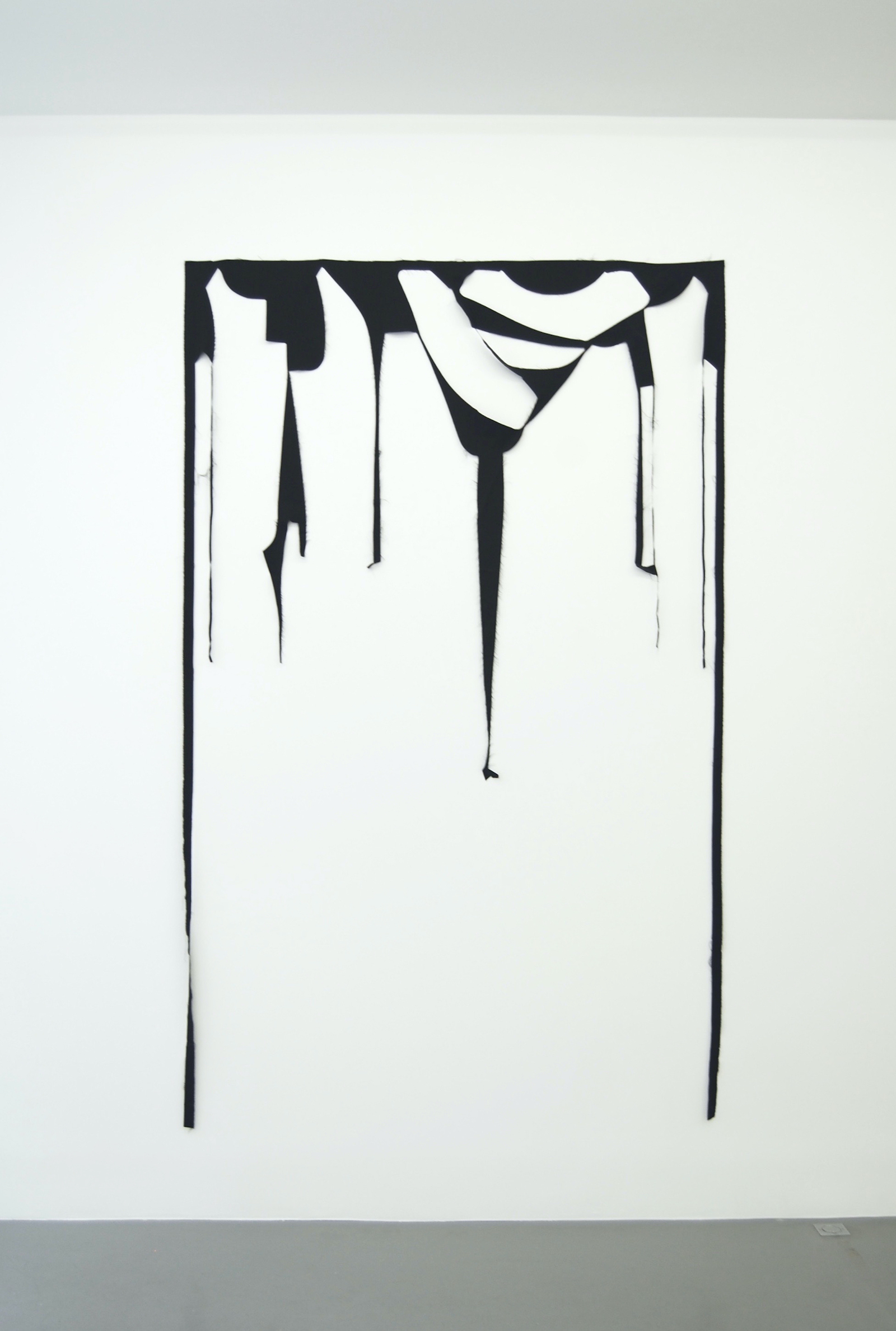
250 x 150 cm
Marion Baruch has, for the past ten years, been intervening on fabric offcuts retrieved from the textile industry in Milan. The artist selects, sorts and arrange those materials, so as to transform those disregarded scraps from the industrial and urban society into forms characterised by a flexible geometry. Hung from the ceiling or pinned on the wall, her works reflect a history, as social and political as individual and sensitive.

160 x 60 cm (each)
Marion Baruch has, for the past ten years, been intervening on fabric offcuts retrieved from the textile industry in Milan. The artist selects, sorts and arrange those materials, so as to transform those disregarded scraps from the industrial and urban society into forms characterised by a flexible geometry. Hung from the ceiling or pinned on the wall, her works reflect a history, as social and political as individual and sensitive.

92 x 53 cm
Marion Baruch has, for the past ten years, been intervening on fabric offcuts retrieved from the textile industry in Milan. The artist selects, sorts and arrange those materials, so as to transform those disregarded scraps from the industrial and urban society into forms characterised by a flexible geometry. Hung from the ceiling or pinned on the wall, her works reflect a history, as social and political as individual and sensitive.
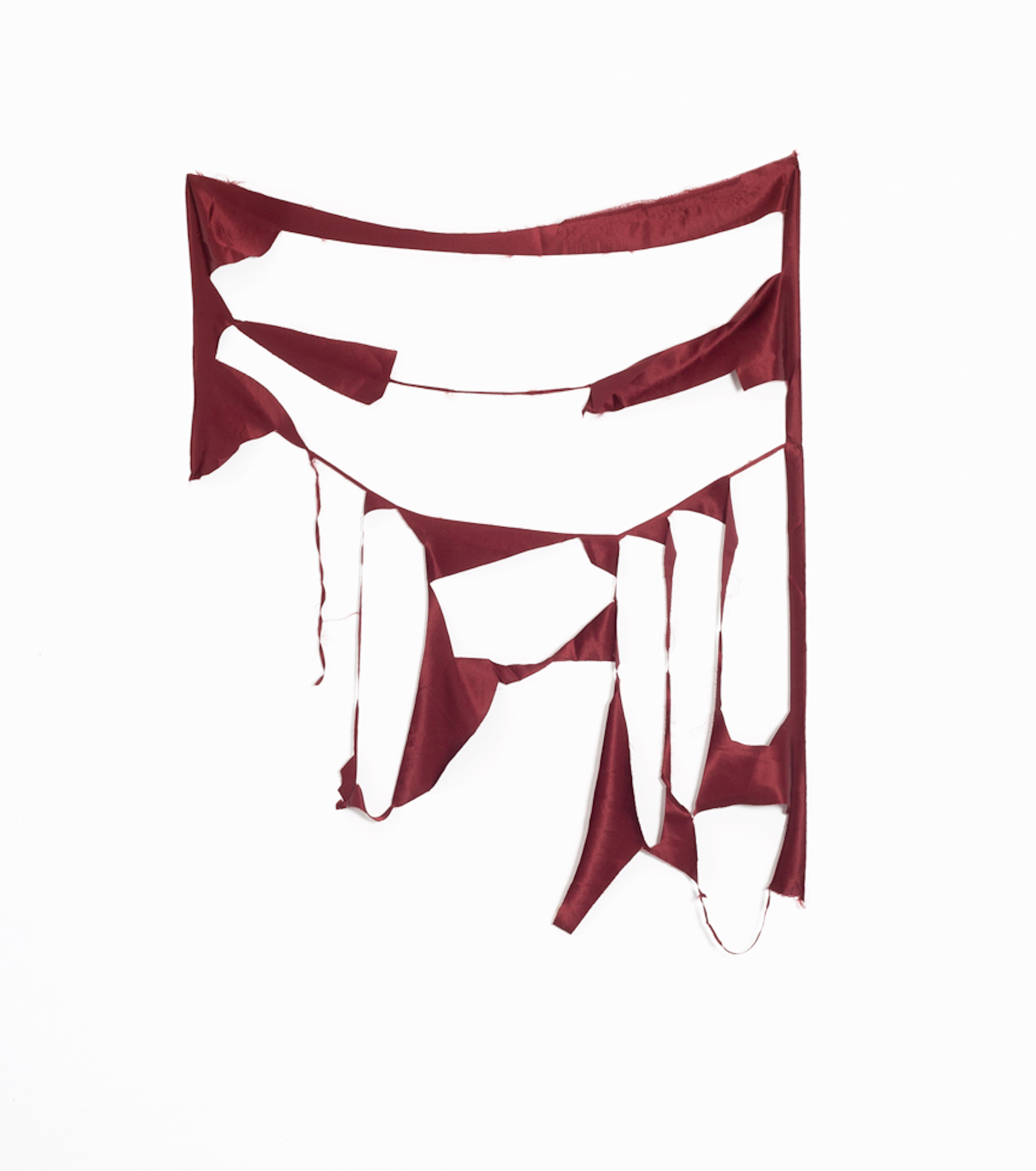
95 x 64 cm
© Margot Montigny
Marion Baruch has, for the past ten years, been intervening on fabric offcuts retrieved from the textile industry in Milan. The artist selects, sorts and arrange those materials, so as to transform those disregarded scraps from the industrial and urban society into forms characterised by a flexible geometry. Hung from the ceiling or pinned on the wall, her works reflect a history, as social and political as individual and sensitive.

95 x 155 cm
Crédit photo Yann Haeberlin
Marion Baruch has, for the past ten years, been intervening on fabric offcuts retrieved from the textile industry in Milan. The artist selects, sorts and arrange those materials, so as to transform those disregarded scraps from the industrial and urban society into forms characterised by a flexible geometry. Hung from the ceiling or pinned on the wall, her works reflect a history, as social and political as individual and sensitive.

199 x 186,5 cm
Marion Baruch's work on remnants from the textile industry refers to a certain nomadism associated with materials and especially fabric. Her sculptures capture the negative of clothes, designed for human and consumption. Nevertheless, this negative she uses follows a very different path, and travels in another realm it was initially supposed to. Positive and negative, emptiness and fullness are intimately connected and complementary for the artist. In Mon corps où es-tu ?, she refers to one of her performances of the similar name carried out in 2009 when she practiced relational art. She had emptied out her apartment in order to fill the place differently by inviting strangers. For her 80th birthday, she furnished a space with boxes of pharmaceuticals, emphasizing the evolution of her aging body. Actually, relationships with others and the body are permanent in Marion Baruch's work.

240 x 151 cm
©Alexander Hana
Marion Baruch has, for the past ten years, been intervening on fabric offcuts retrieved from the textile industry in Milan. The artist selects, sorts and arrange those materials, so as to transform those disregarded scraps from the industrial and urban society into forms characterised by a flexible geometry. Hung from the ceiling or pinned on the wall, her works reflect a history, as social and political as individual and sensitive.
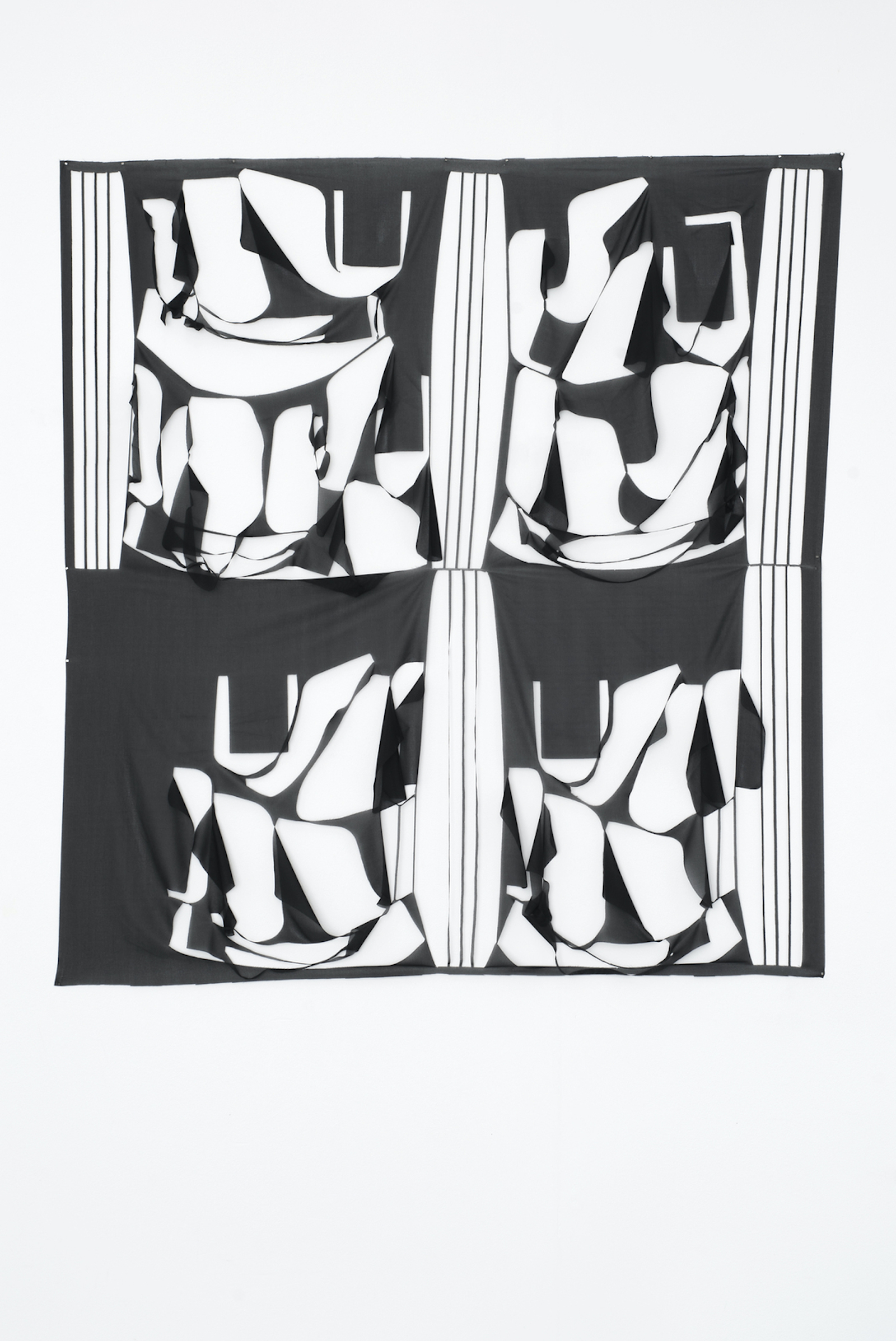
180 x 160 cm
Crédit photo Yann Haeberlin
Marion Baruch has, for the past ten years, been intervening on fabric offcuts retrieved from the textile industry in Milan. The artist selects, sorts and arrange those materials, so as to transform those disregarded scraps from the industrial and urban society into forms characterised by a flexible geometry. Hung from the ceiling or pinned on the wall, her works reflect a history, as social and political as individual and sensitive.
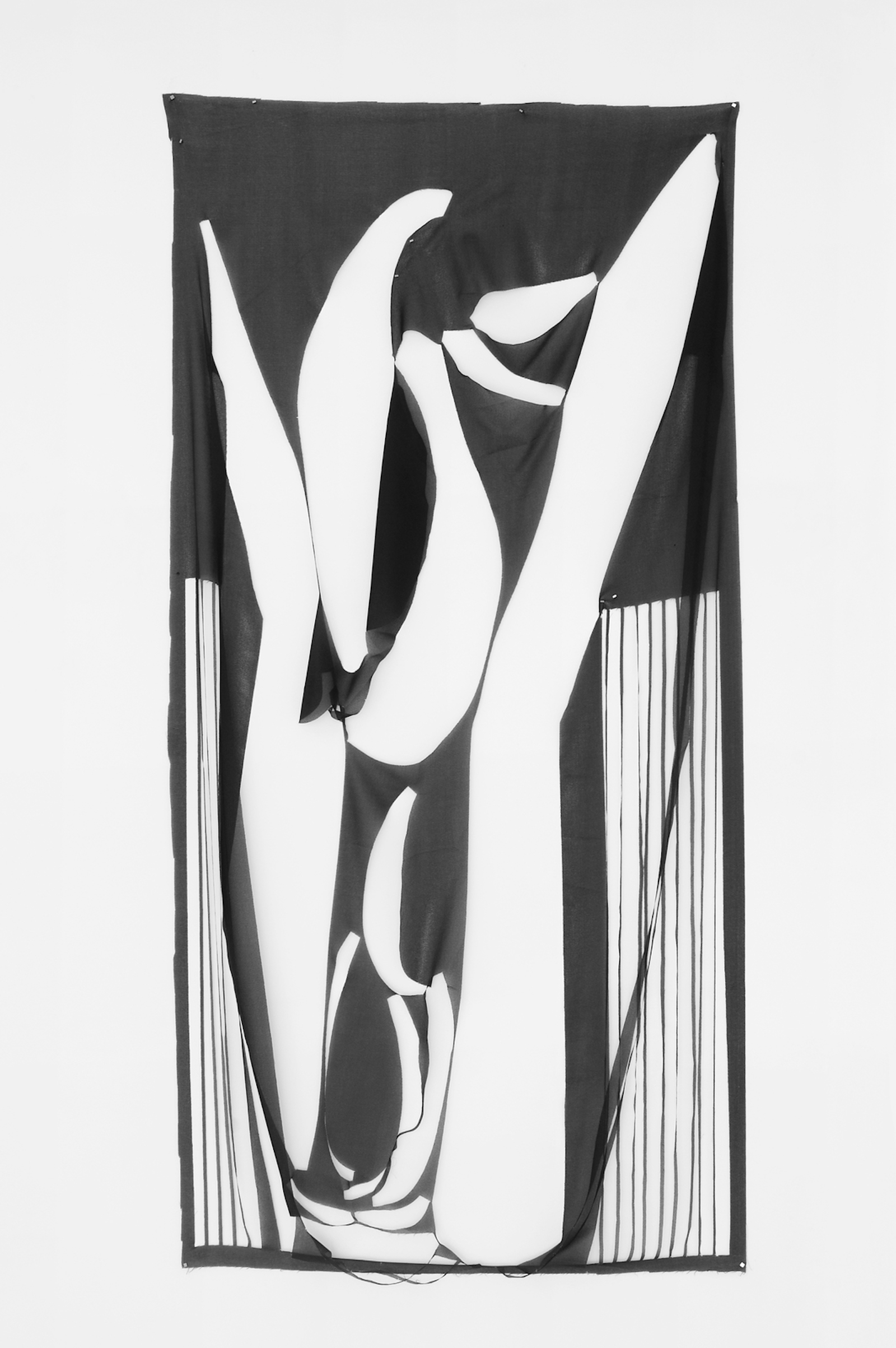
160 x 74 cm
Crédit photo Yann Haeberlin
Marion Baruch has, for the past ten years, been intervening on fabric offcuts retrieved from the textile industry in Milan. The artist selects, sorts and arrange those materials, so as to transform those disregarded scraps from the industrial and urban society into forms characterised by a flexible geometry. Hung from the ceiling or pinned on the wall, her works reflect a history, as social and political as individual and sensitive.
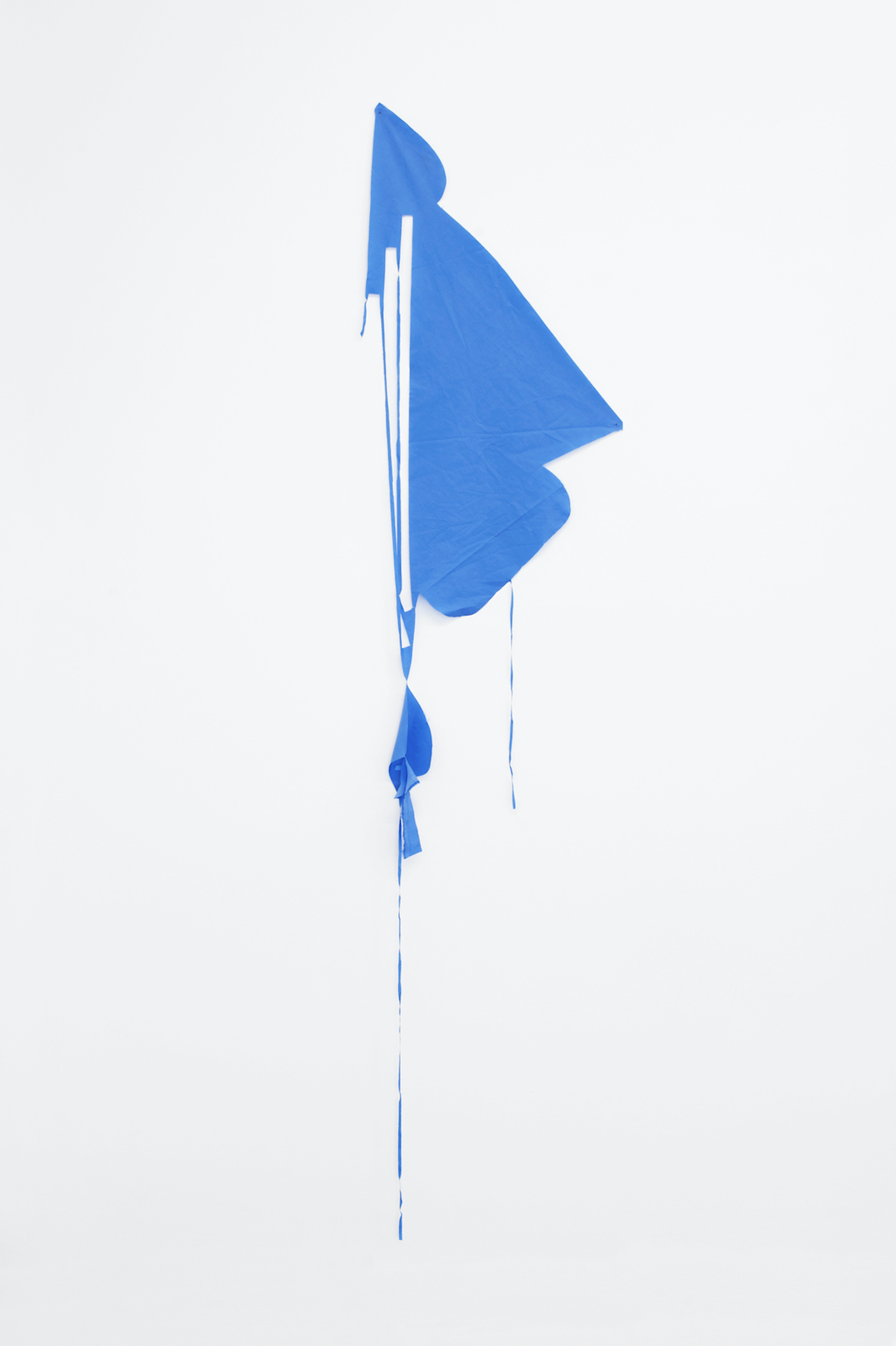
202 x 46 cm
Crédit photo Yann Haeberlin
Marion Baruch has, for the past ten years, been intervening on fabric offcuts retrieved from the textile industry in Milan. The artist selects, sorts and arrange those materials, so as to transform those disregarded scraps from the industrial and urban society into forms characterised by a flexible geometry. Hung from the ceiling or pinned on the wall, her works reflect a history, as social and political as individual and sensitive.
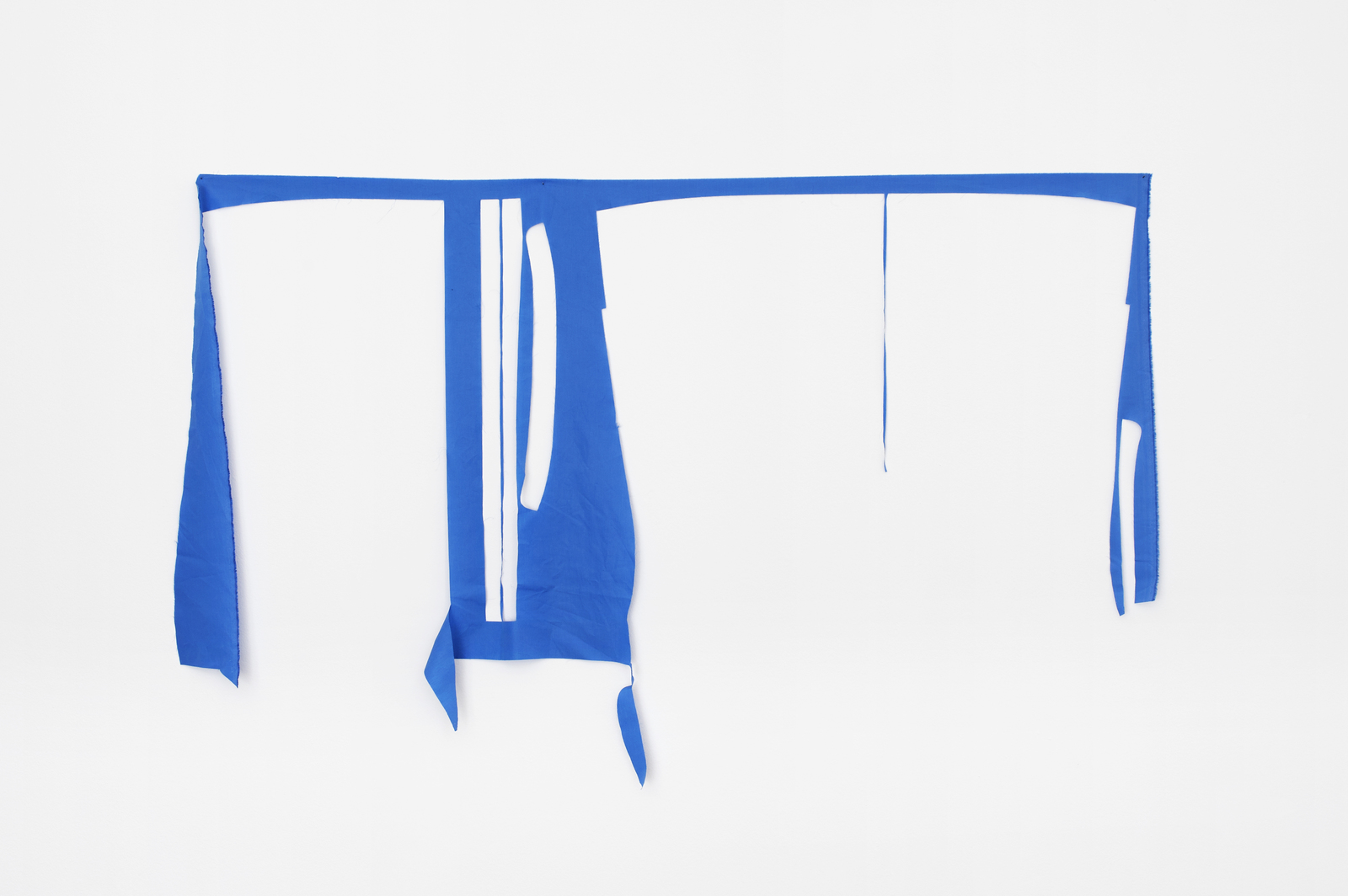
98 x 157 cm
Crédit photo Yann Haeberlin
Marion Baruch has, for the past ten years, been intervening on fabric offcuts retrieved from the textile industry in Milan. The artist selects, sorts and arrange those materials, so as to transform those disregarded scraps from the industrial and urban society into forms characterised by a flexible geometry. Hung from the ceiling or pinned on the wall, her works reflect a history, as social and political as individual and sensitive.

87 x 107 cm
Crédit photo Yann Haeberlin
Marion Baruch has, for the past ten years, been intervening on fabric offcuts retrieved from the textile industry in Milan. The artist selects, sorts and arrange those materials, so as to transform those disregarded scraps from the industrial and urban society into forms characterised by a flexible geometry. Hung from the ceiling or pinned on the wall, her works reflect a history, as social and political as individual and sensitive.
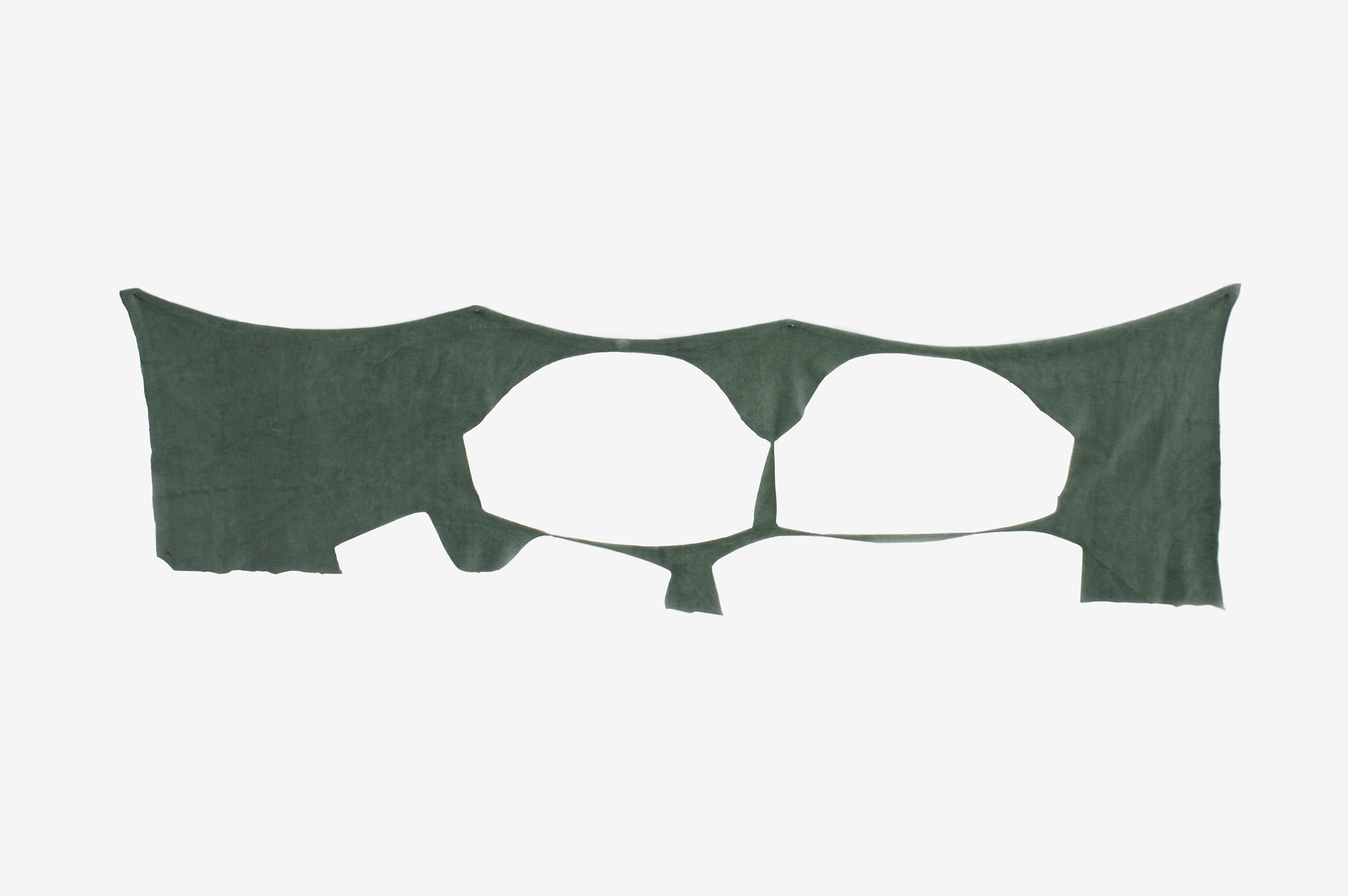
44 x 167 cm
Crédit photo Yann Haeberlin
Marion Baruch has, for the past ten years, been intervening on fabric offcuts retrieved from the textile industry in Milan. The artist selects, sorts and arrange those materials, so as to transform those disregarded scraps from the industrial and urban society into forms characterised by a flexible geometry. Hung from the ceiling or pinned on the wall, her works reflect a history, as social and political as individual and sensitive.

88 x 106 cm
Crédit photo Yann Haeberlin
Marion Baruch has, for the past ten years, been intervening on fabric offcuts retrieved from the textile industry in Milan. The artist selects, sorts and arrange those materials, so as to transform those disregarded scraps from the industrial and urban society into forms characterised by a flexible geometry. Hung from the ceiling or pinned on the wall, her works reflect a history, as social and political as individual and sensitive.

73 x 152 cm
Crédit photo Yann Haeberlin
Marion Baruch has, for the past ten years, been intervening on fabric offcuts retrieved from the textile industry in Milan. The artist selects, sorts and arrange those materials, so as to transform those disregarded scraps from the industrial and urban society into forms characterised by a flexible geometry. Hung from the ceiling or pinned on the wall, her works reflect a history, as social and political as individual and sensitive.
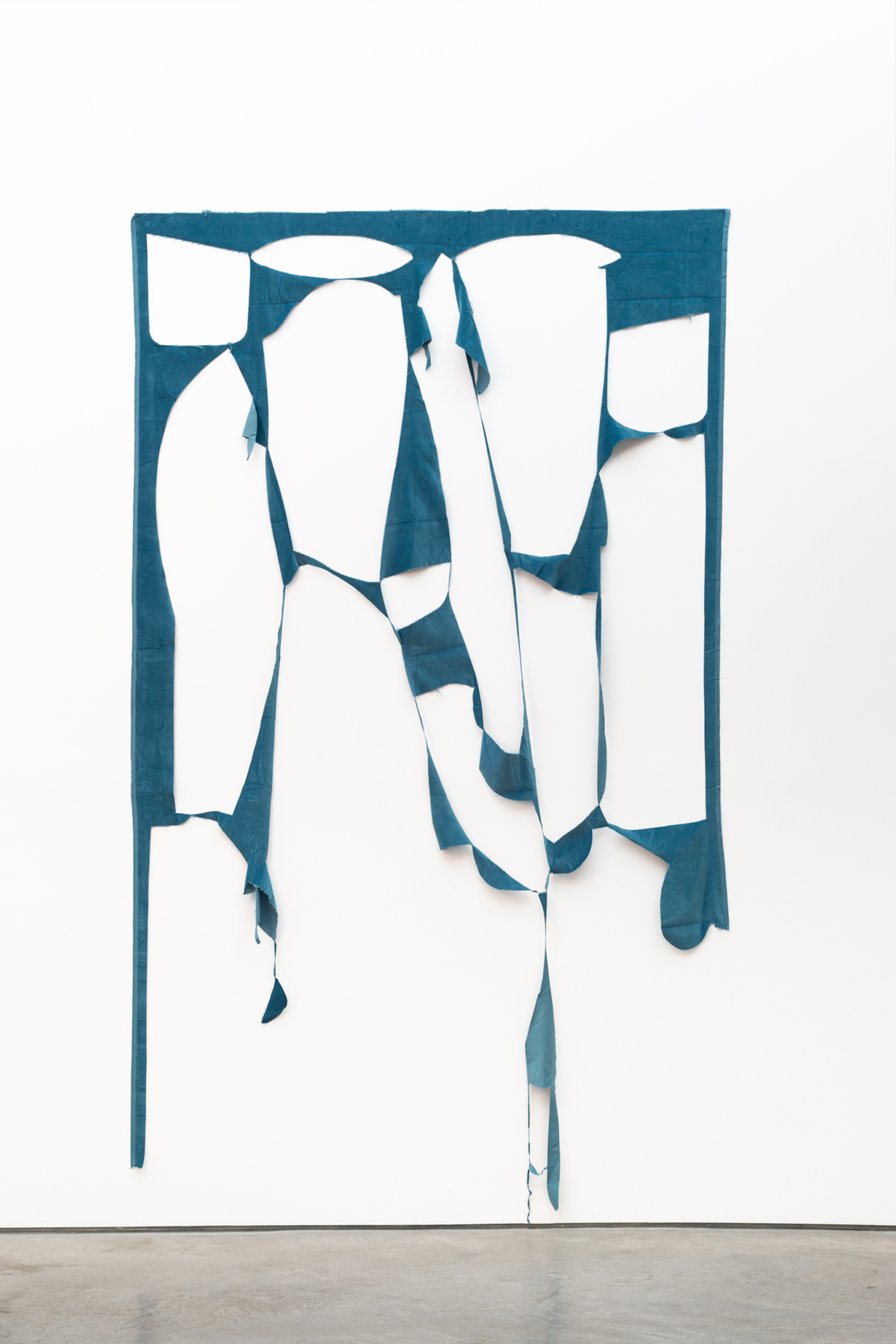
242 x 145 cm
©Margot Montigny
Marion Baruch has, for the past ten years, been intervening on fabric offcuts retrieved from the textile industry in Milan. The artist selects, sorts and arrange those materials, so as to transform those disregarded scraps from the industrial and urban society into forms characterised by a flexible geometry. Hung from the ceiling or pinned on the wall, her works reflect a history, as social and political as individual and sensitive.
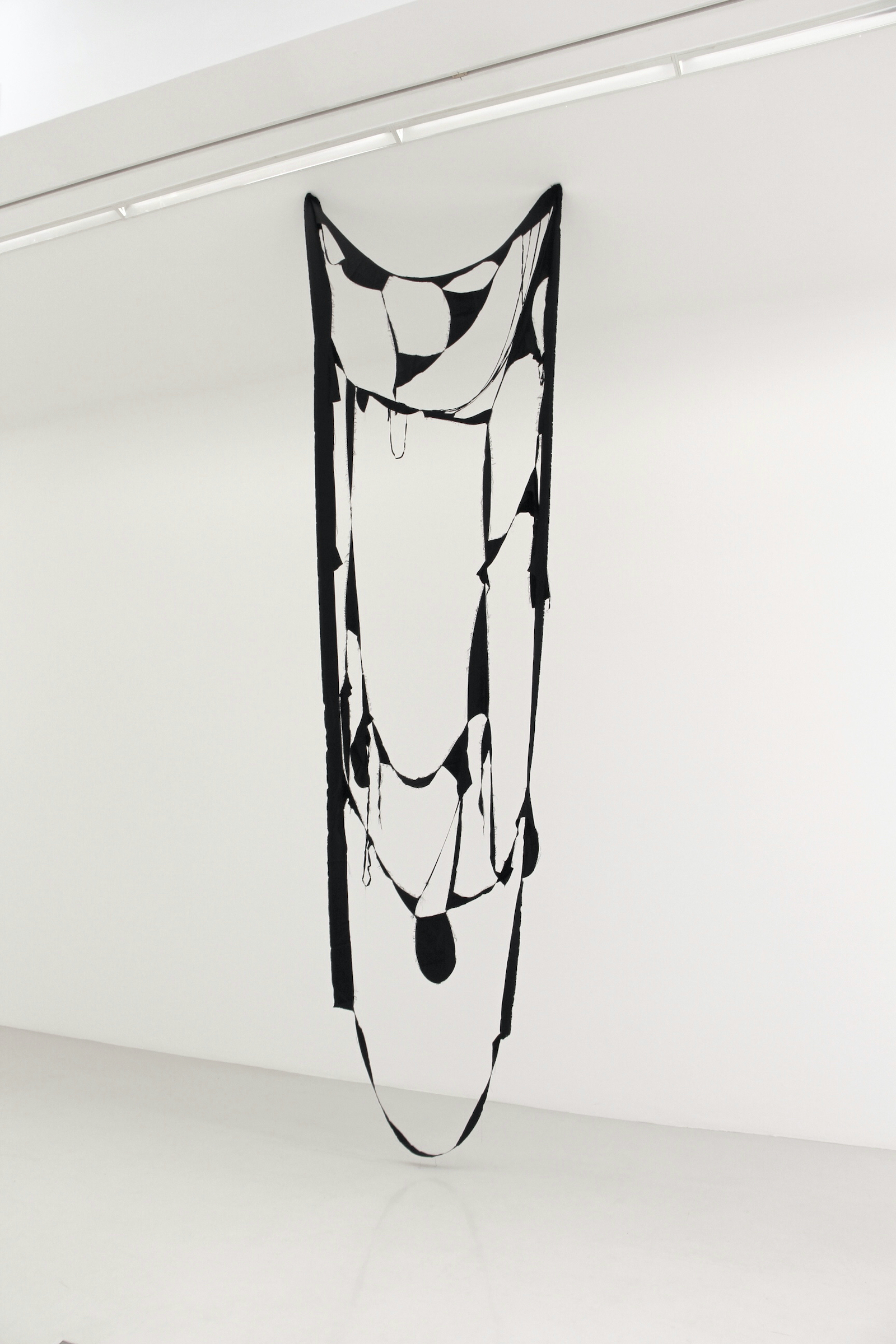
420 x 130 cm
Marion Baruch has, for the past ten years, been intervening on fabric offcuts retrieved from the textile industry in Milan. The artist selects, sorts and arrange those materials, so as to transform those disregarded scraps from the industrial and urban society into forms characterised by a flexible geometry. Hung from the ceiling or pinned on the wall, her works reflect a history, as social and political as individual and sensitive.

48 x 119 cm
The triptych Tre Ovali, created in 2015 for an exhibition in Italy, consists of three scraps of fabric with empty ovals in their centre. Marion Baruch imagined these shapes as small objects intended for sale, conceptually creating a small shop. As often with the artist, this relationship between the void - here these three holes - and its imaginary function ironically creates a dialogue to make these scraps destined for oblivion into consumer products; or how to make fun of over-consumption by selling "nothing".
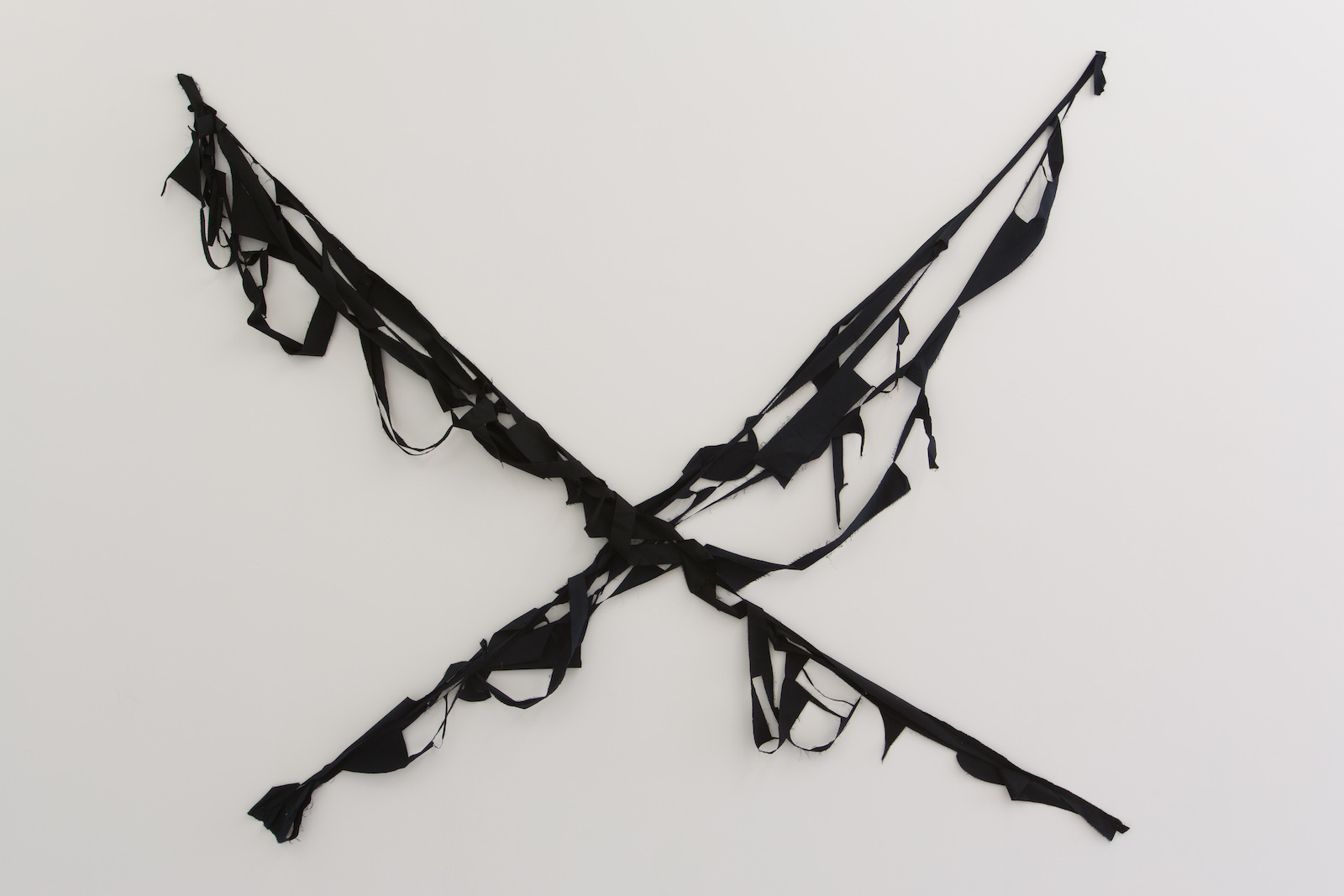
223 x 226 cm
©Alexander Hana
Marion Baruch has, for the past ten years, been intervening on fabric offcuts retrieved from the textile industry in Milan. The artist selects, sorts and arrange those materials, so as to transform those disregarded scraps from the industrial and urban society into forms characterised by a flexible geometry. Hung from the ceiling or pinned on the wall, her works reflect a history, as social and political as individual and sensitive.
Collections of the Museum of Modern Art of the City of Paris

133 x 55 cm
After a long period practicing relational art, Marion Baruch has made a major artistic shift by returning to formal art from the end of the 2000s. Creating artworks from remnants of fabric collected in the Milanese textile industry, she initiated this new artistic cycle by quoting the great masters of modern art who influenced her. She then turned to portraits and music references. In the Arpa series, the artist produces a resonance between the drawings of the fabric and the stringed instruments, thus emphasizing on the analogy between architecture and music.
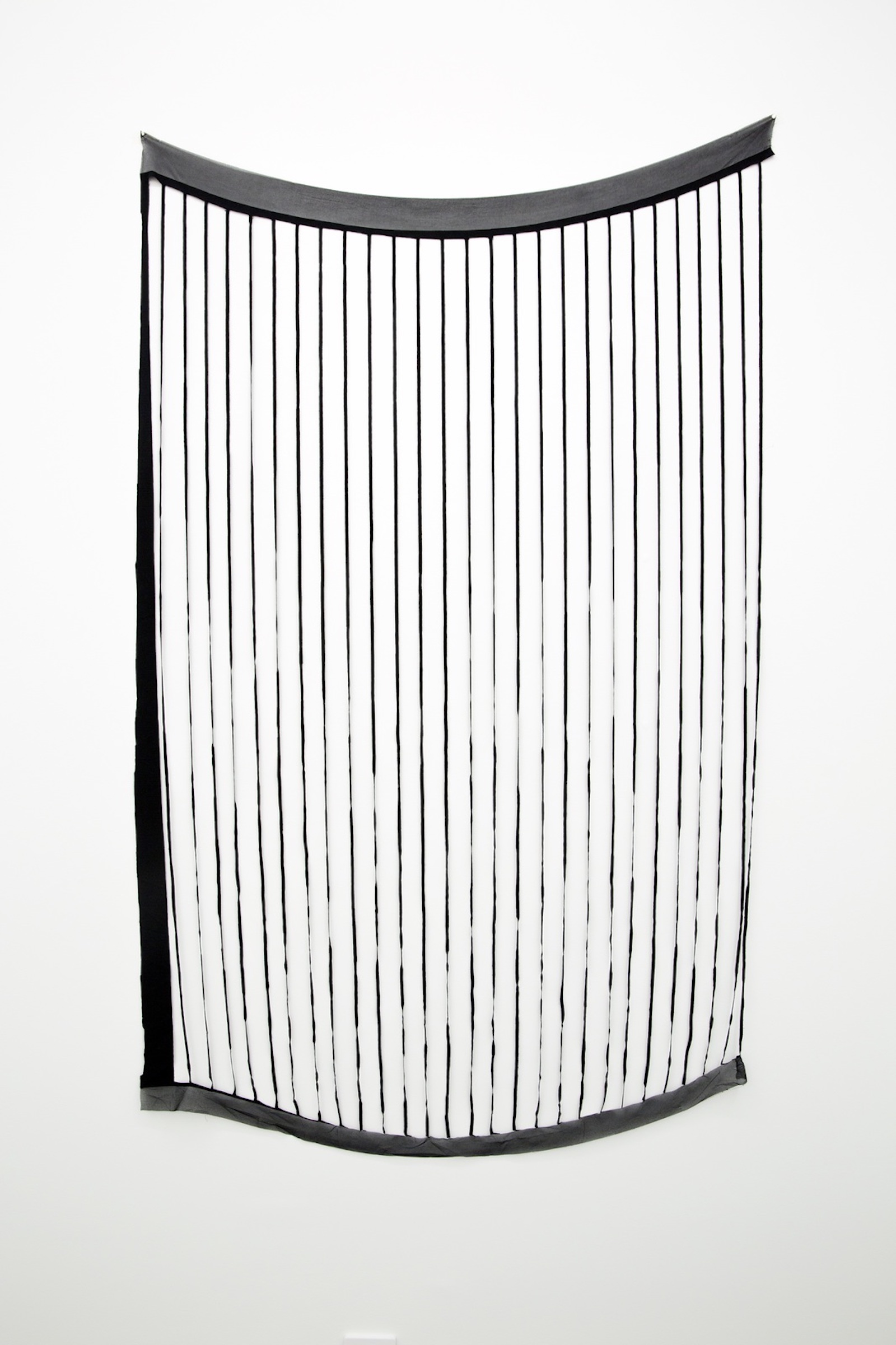
155 x 100 cm
Marion Baruch has, for the past ten years, been intervening on fabric offcuts retrieved from the textile industry in Milan. The artist selects, sorts and arrange those materials, so as to transform those disregarded scraps from the industrial and urban society into forms characterised by a flexible geometry. Hung from the ceiling or pinned on the wall, her works reflect a history, as social and political as individual and sensitive.
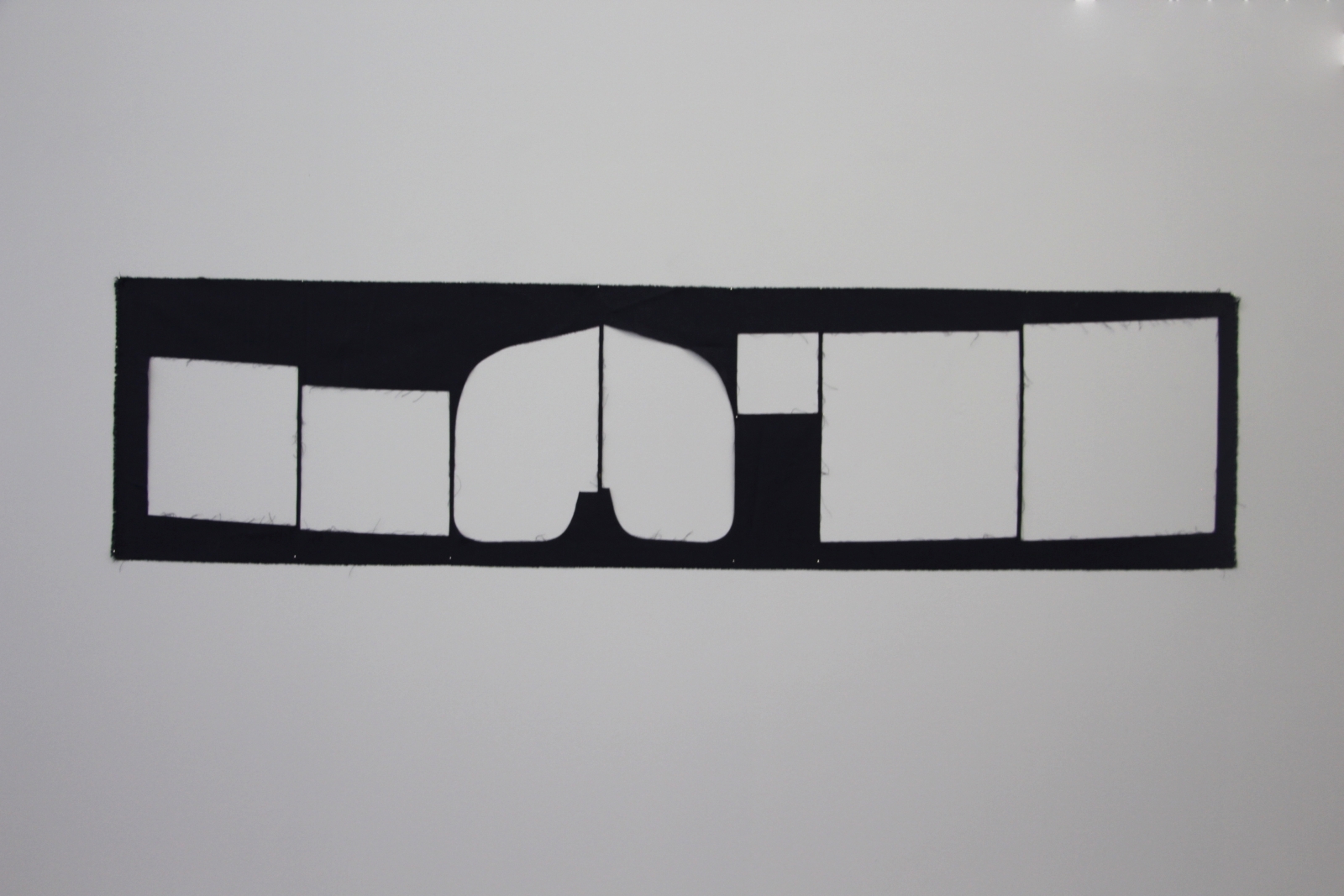
37,5 x 157 cm
After a long period practicing conceptual then relational art, Marion Baruch encountered physical difficulties linked to her advanced age. Hence, she operated a major turning point in her career at the end of the 2000s. She returns toward formal art, and discovers the pictorial potential of fabric remnants she collects from the textile industry. In this new artistic cycle, her first move is to link her work on these materials fated to oblivion with the great master of modern art who influenced her. Marion Baruch thus starts to name her artwork by dedicating them to artists she loves or she has loved, like spontaneous and free quotations to art history.
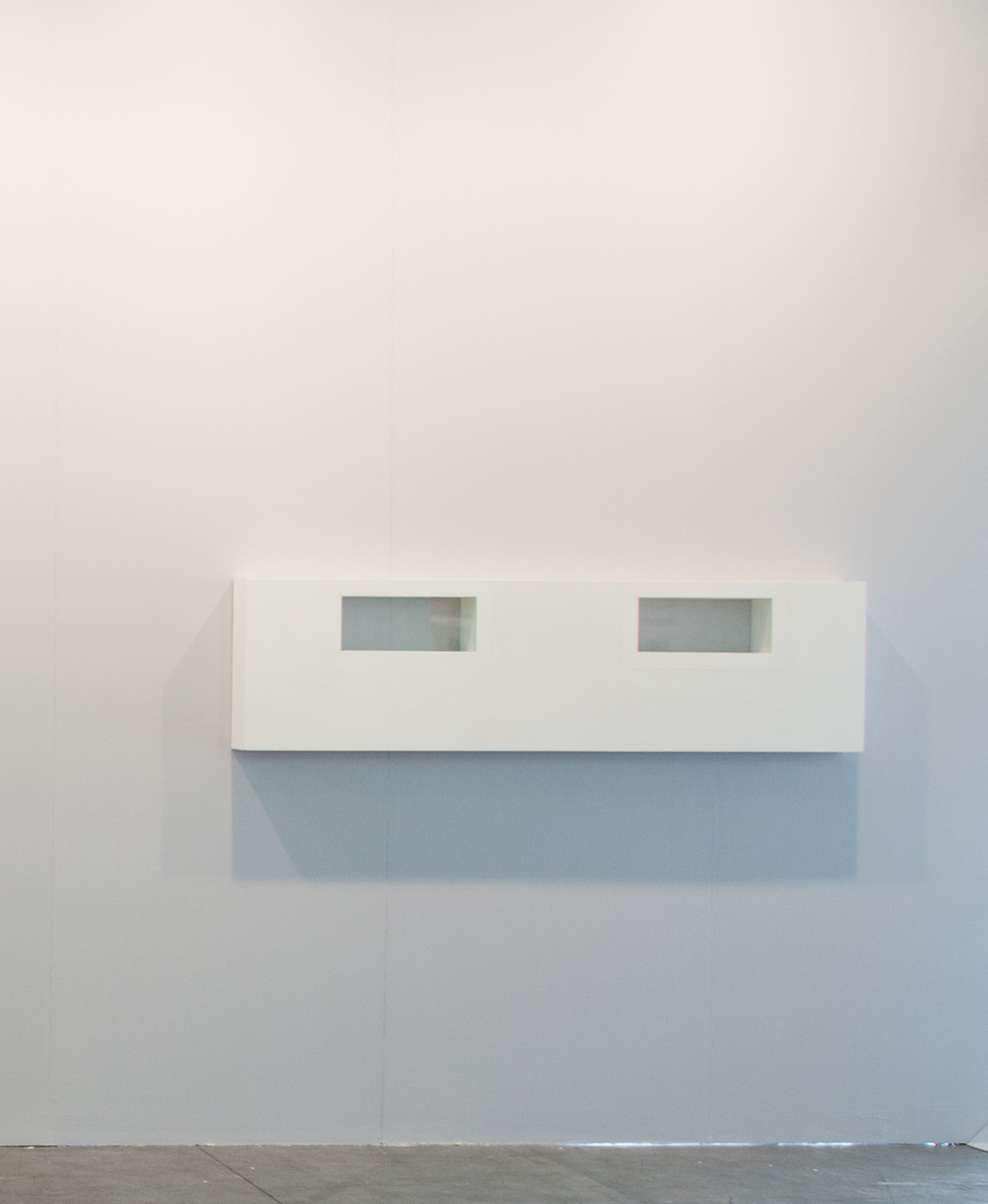
185 x 50 x 12,5 cm
©Elena Perlino

various dimensions
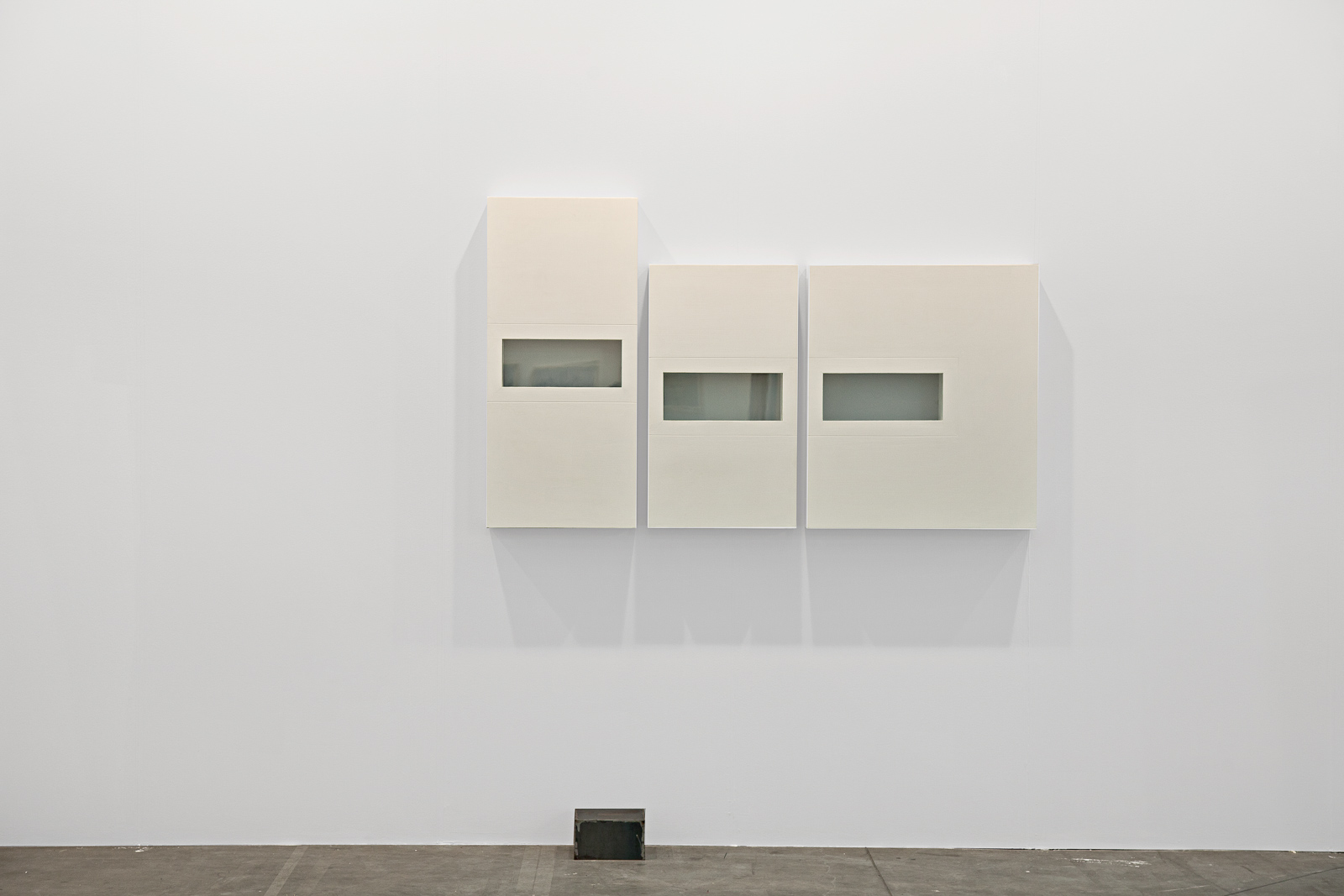
110,5 x 177,2 x 12,5 cm
©Elena Perlino
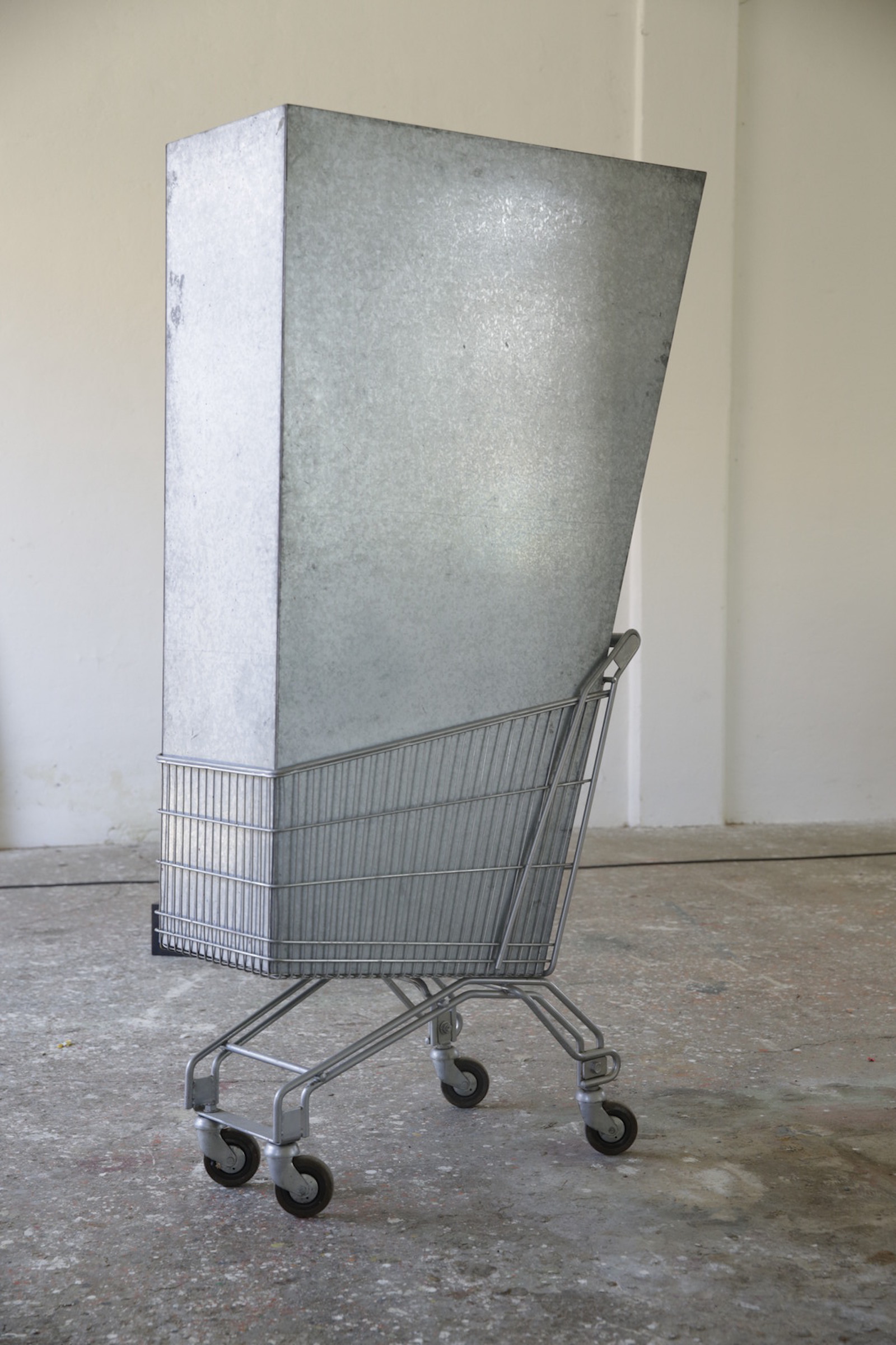
177, 5 x 90 x 48 cm
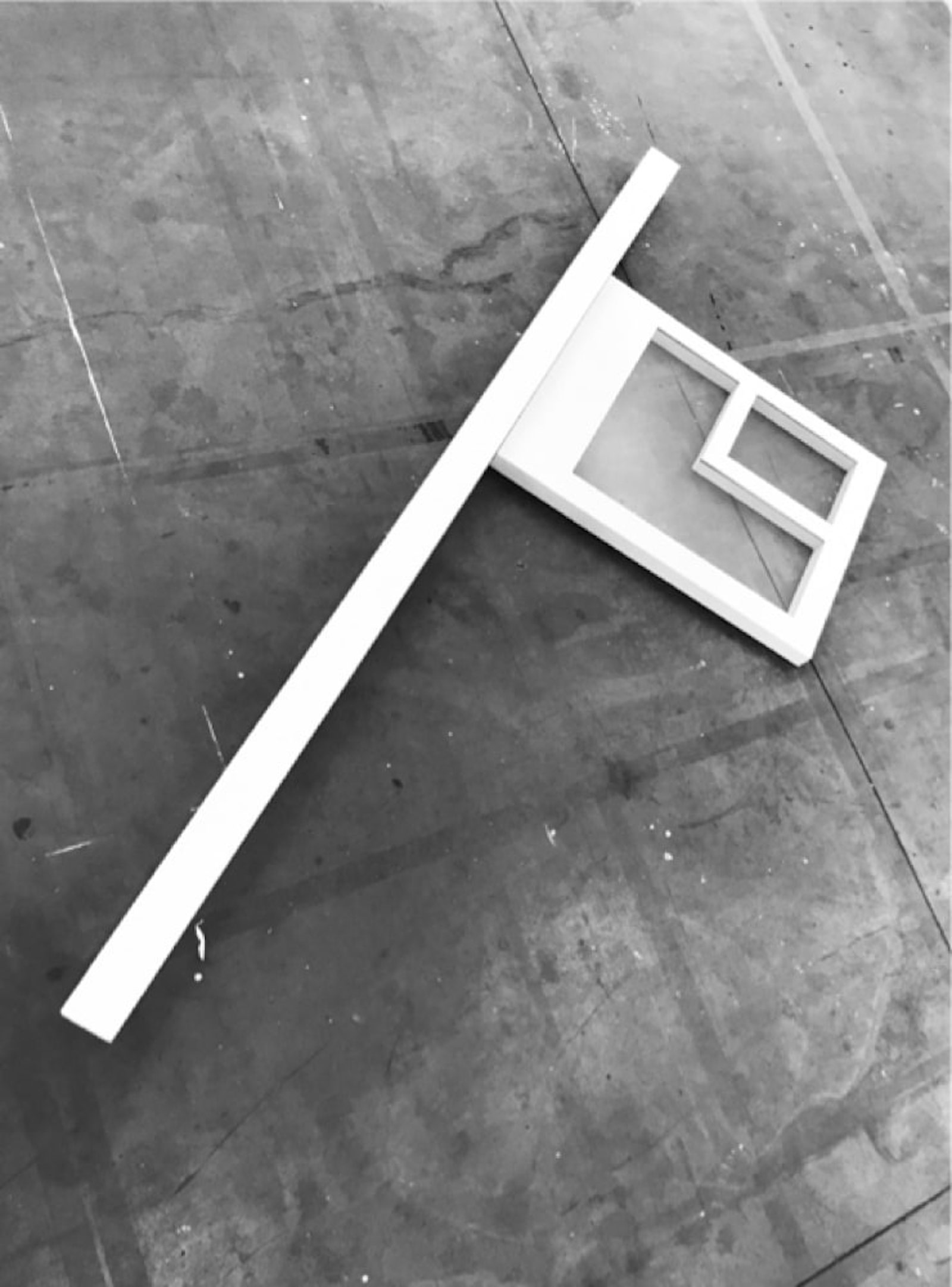
243 x 93,5 x 10,5 cm
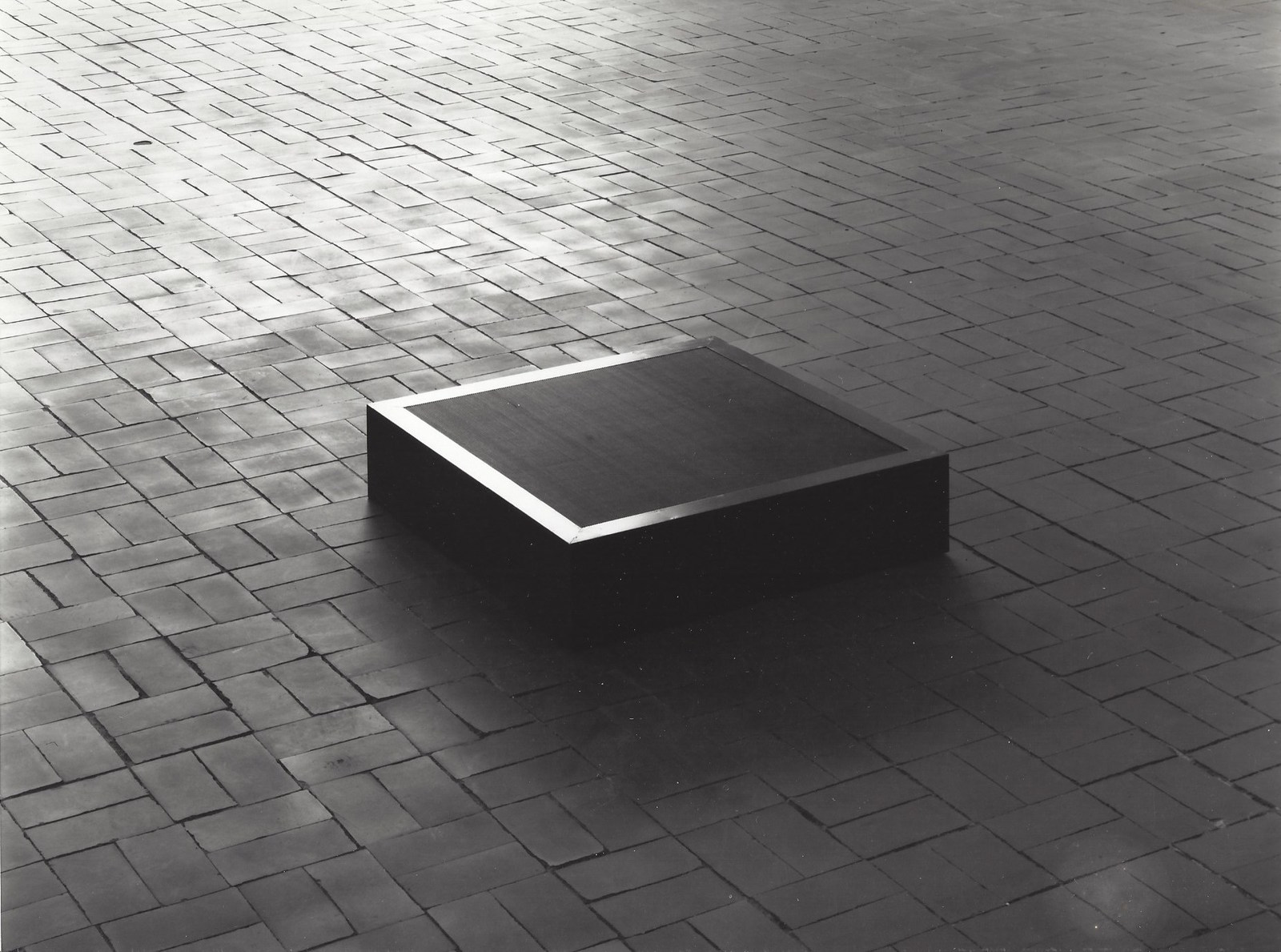
40 x 40 cm

137 x 158 x 2,5 cm
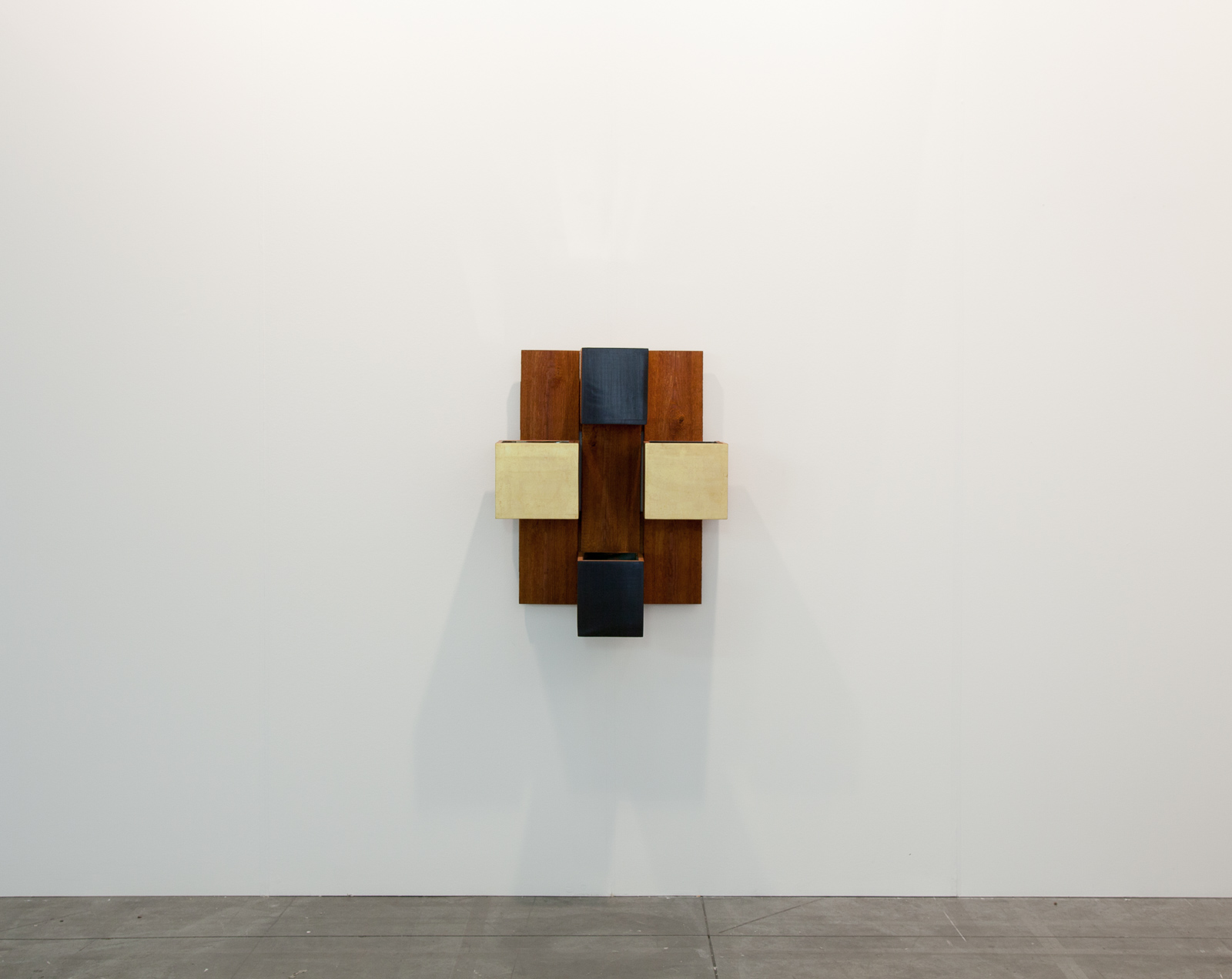
78,7 x 63,5 x 24,1 cm
©Elena Perlino
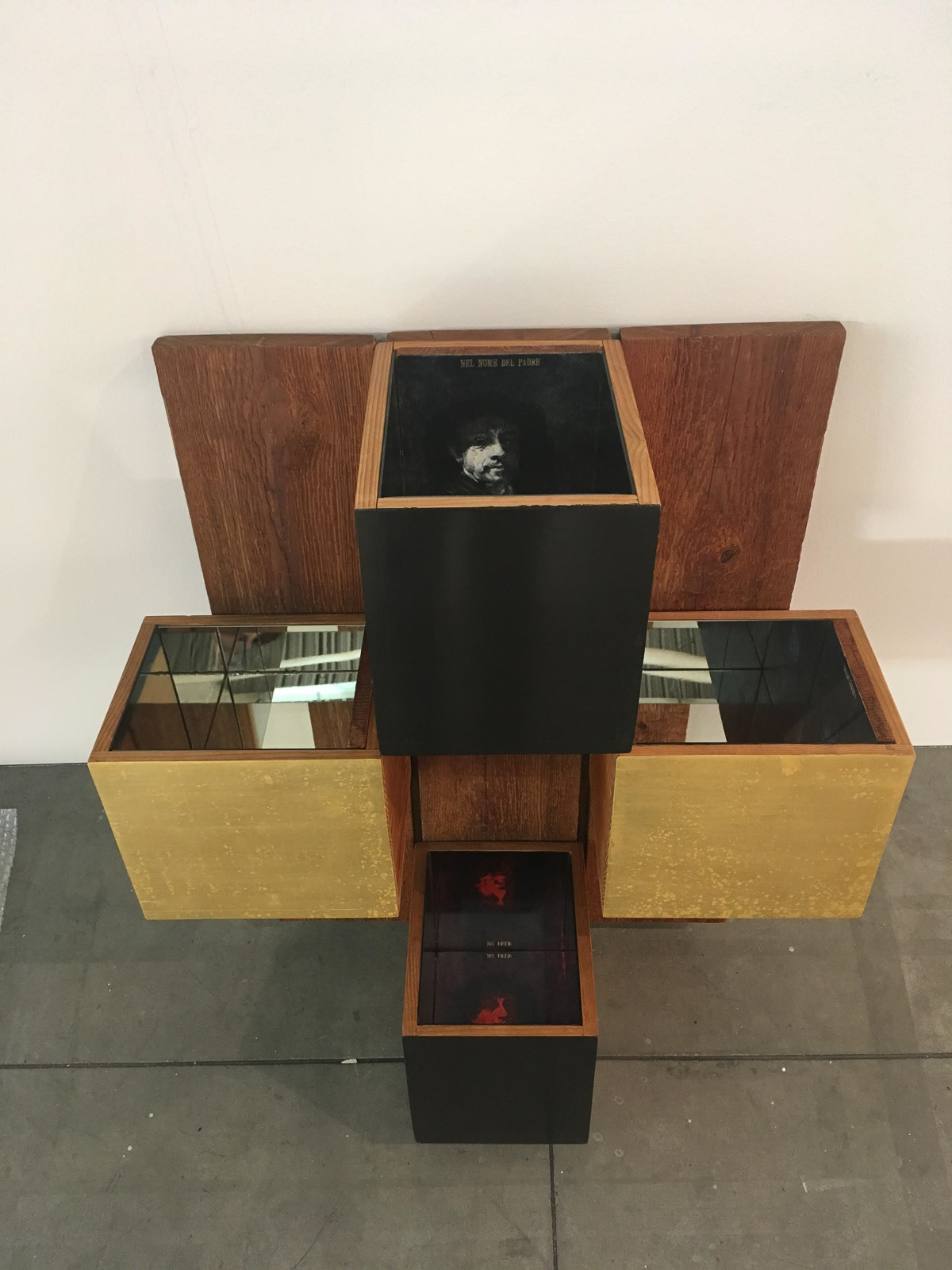
78,7 x 63,5 x 24,1 cm
©Elena Perlino

Color print booklet page
21 x 15 cm
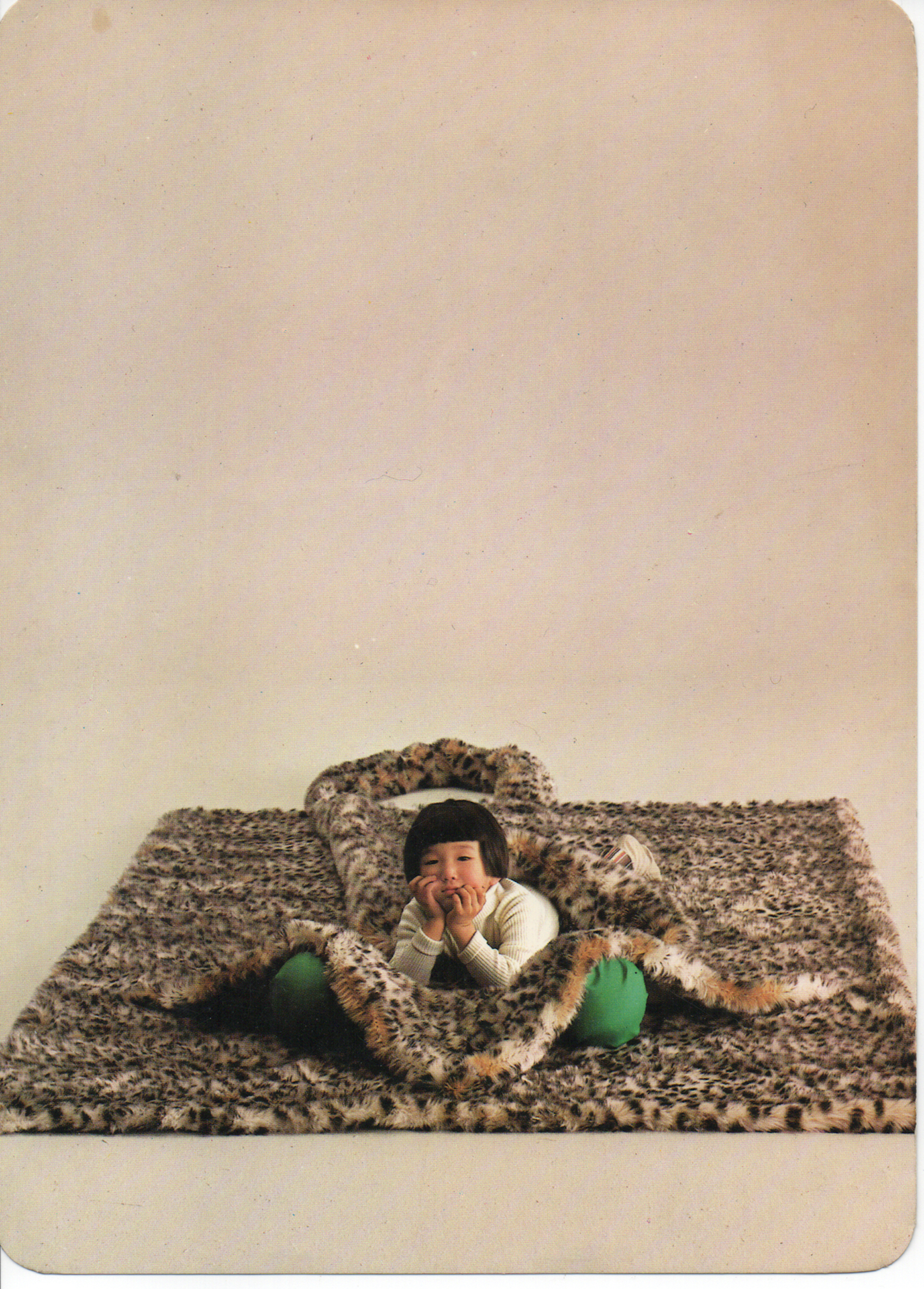
Color print booklet page
21 x 15 cm
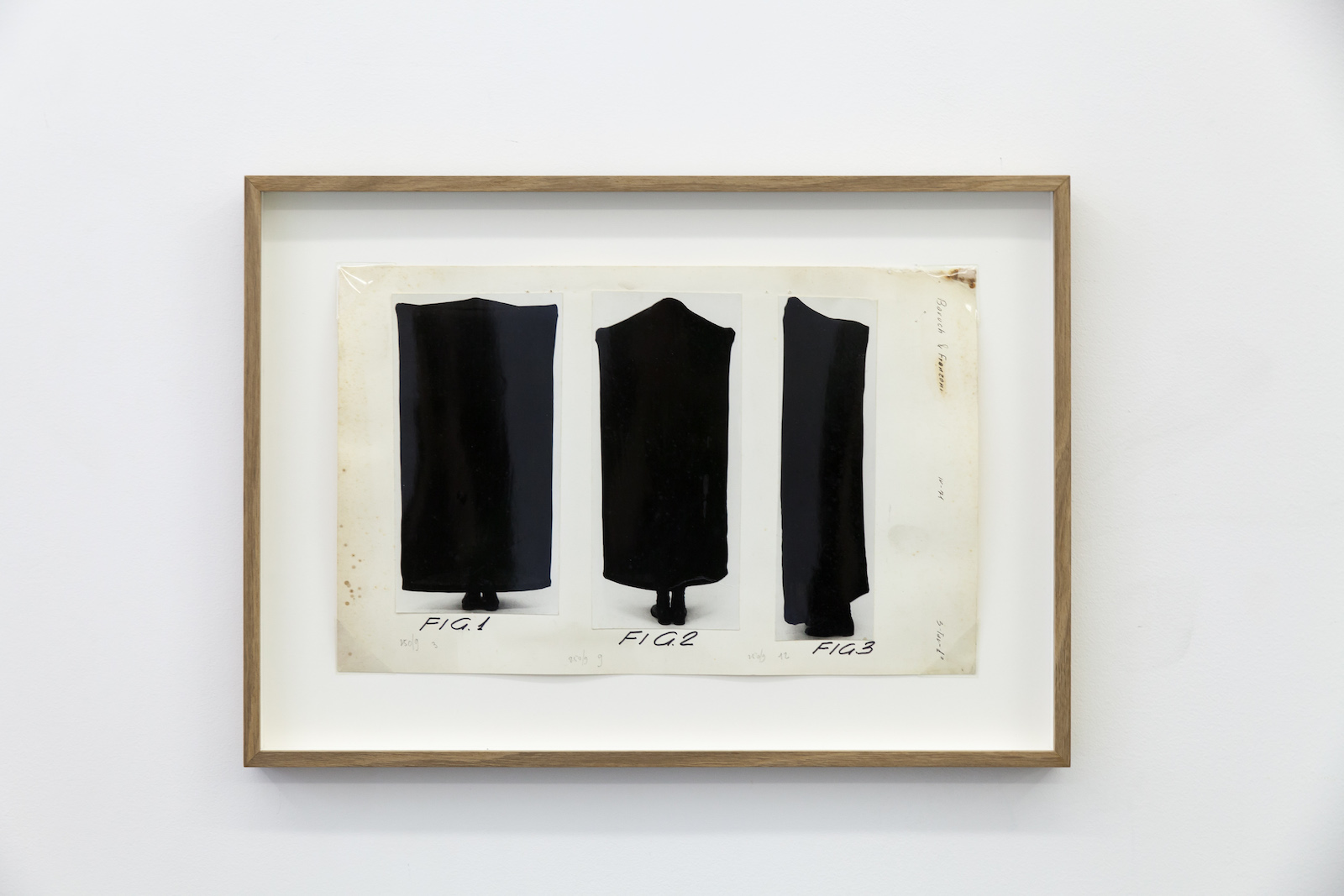
Image: 21 x 33 cm each
Abito-Contenitore, réalisé en 1970, fait partie des travaux de début de carrière de Marion Baruch. Cette série de neuf photographies argentiques disposées sur trois cartons souligne l'étroite relation entre le tissu et le corps féminin. Elle s'intéresse ici au rapport du corps à la société, dans un contexte marqué de libération de la femme. L'artiste porte son regard sur la manière dont le textile se construit en boite de dialogue avec l'extérieur, introduisant une conception artistique aux formes féminines.
Le corps dissimulé sous l'étoffe oscille entre sculpture et performance, mettant en lumière le mouvement féminin au contact du tissu, et son importance au sein d'une société marquée par l'objectivation et l'instrumentalisation du corps des femmes. Ainsi, Marion Baruch dans cette oeuvre décrit une époque, en s'inscrivant dans la lignée de l'art féministe des années 1970.
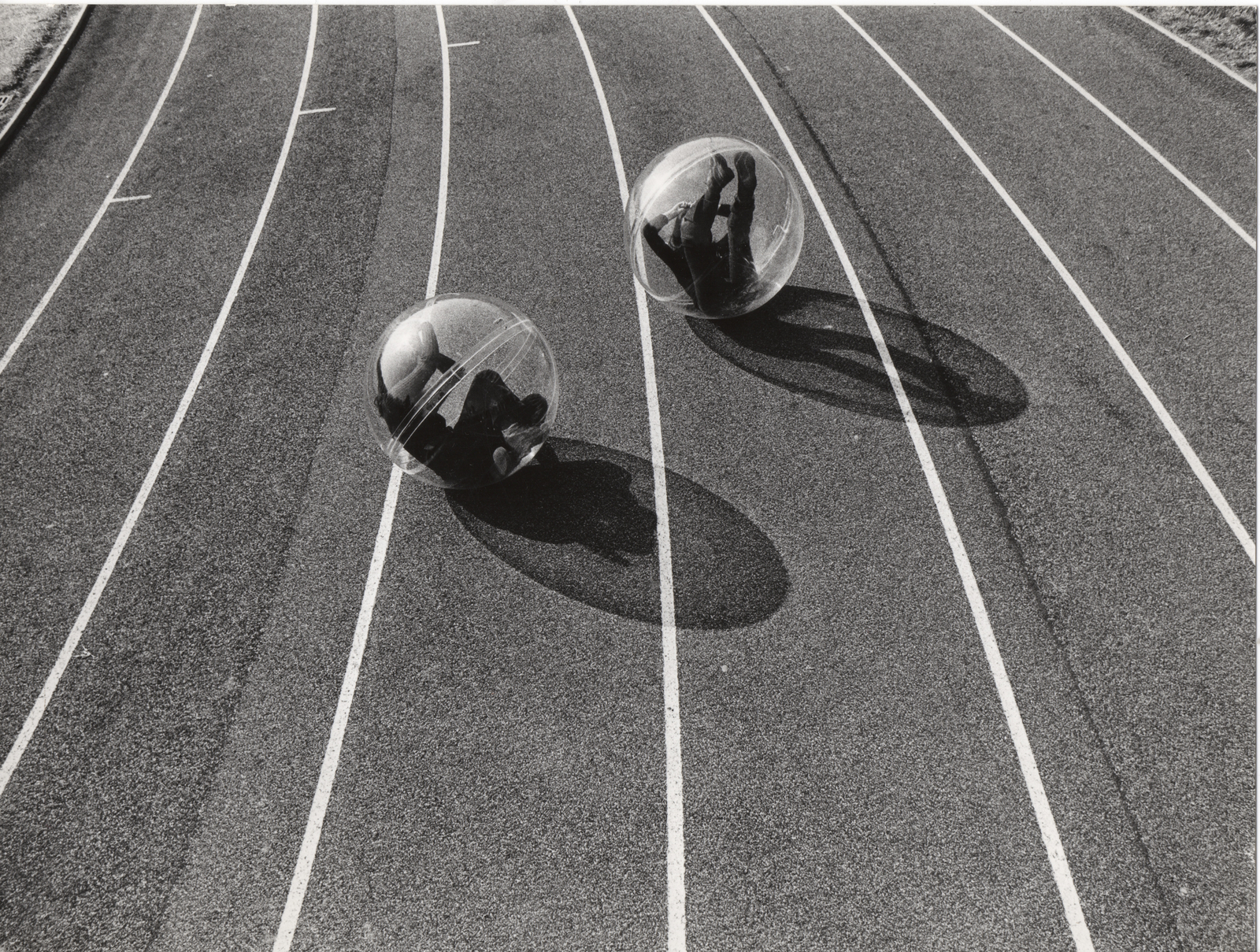
18 x 24 cm
© Gianni Berengo Gardin
Provenance: artist's studio
Exhibitions :
- Marion Baruch, Retrospektive-Innenausseninnen, Kunstmuseum Luzern, Luzern, Switzerland, 2020.
- Gigantisme - Art et Industrie, Triennale 2019, Frac Grand Large - Hauts de France, curated by Keren Detton, Grégory Lang, Géraldine Courbe and Sophie Warlop, Dunkerque, France, 2019-2020.
- Life A User's Manual, Art Encounters, Contemporary Art Biennial , Timisoara, Romania, 30th September- 5th November 2017.
Bibliography :
- Gigantisme, Art et industrie, Frac Grand Large, Dunkerque, éditions BeauxArts, 2019, p.21.
- Artreview, Mai 2017, p. 80 - 81.

Image: Various sizes (7 x 9,5 inches each approximatively)
Exhibitions :
- Marion Baruch, Retrospektive-Innenausseninnen, Kunstmuseum Luzern, Luzern, Switzerland, 2020.
- « Le pressentiment de mon indiscipline »/ dialogue on the notion of line, Galerie Anne-Sarah Bénichou, Paris, France, 2019.
- Life A User's Manual, Art Encounters, Contemporary Art Biennial, Timisoara, Romania, 2017.
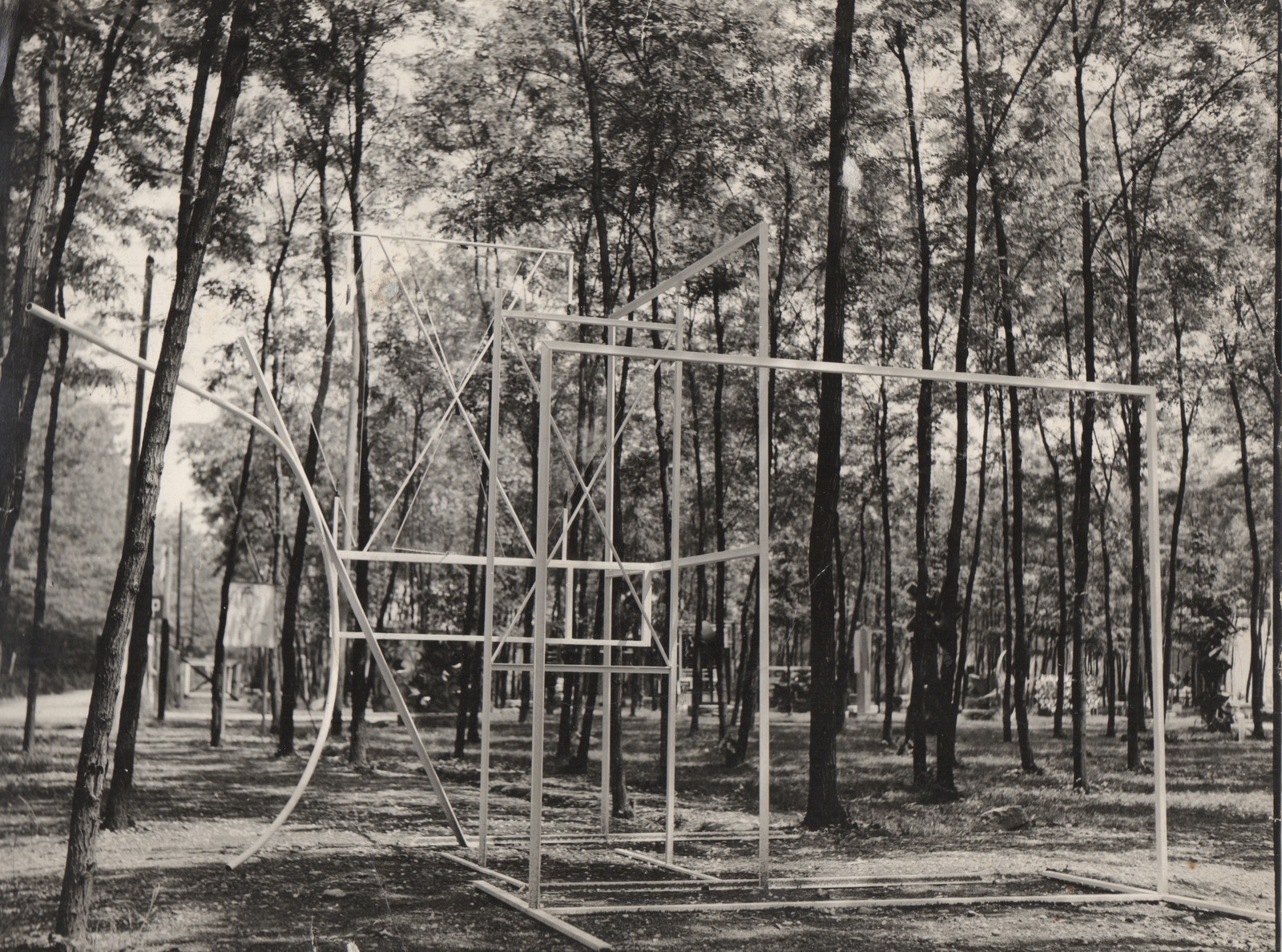
Image: Various sizes (7 x 9,5 inches each approximatively)
Exhibitions :
- Marion Baruch, Retrospektive-Innenausseninnen, Kunstmuseum Luzern, Luzern, Switzerland, 2020.
- « Le pressentiment de mon indiscipline »/ dialogue on the notion of line, Galerie Anne-Sarah Bénichou, Paris, France, 2019.
- Life A User's Manual, Art Encounters, Contemporary Art Biennial, Timisoara, Romania, 2017.

Image: Various sizes (7 x 9,5 inches each approximatively)
Exhibitions :
- Marion Baruch, Retrospektive-Innenausseninnen, Kunstmuseum Luzern, Luzern, Switzerland, 2020.
- « Le pressentiment de mon indiscipline »/ dialogue on the notion of line, Galerie Anne-Sarah Bénichou, Paris, France, 2019.
- Life A User's Manual, Art Encounters, Contemporary Art Biennial, Timisoara, Romania, 2017.
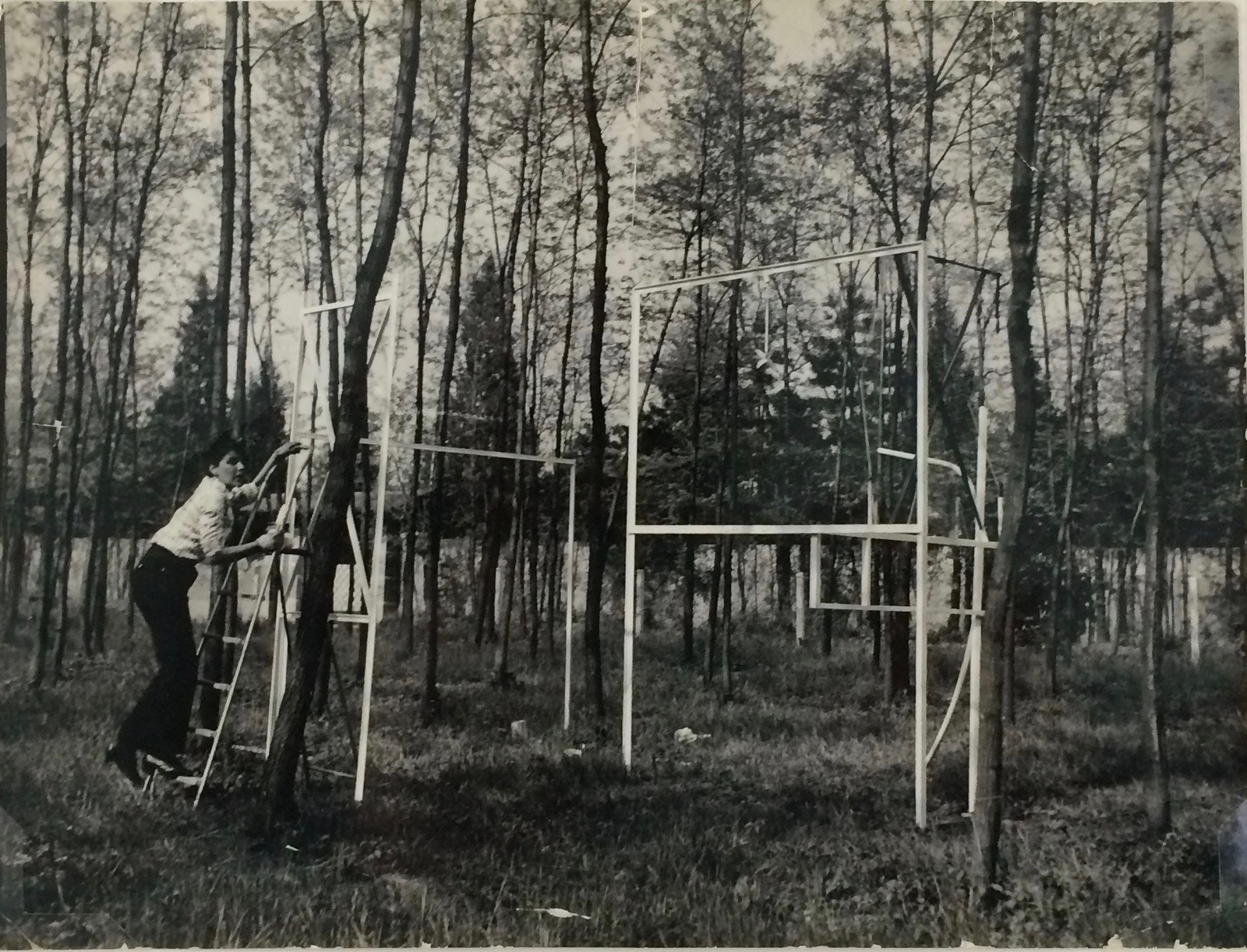
Image: Various sizes (7 x 9,5 inches each approximatively)
Exhibitions :
- Marion Baruch, Retrospektive-Innenausseninnen, Kunstmuseum Luzern, Luzern, Switzerland, 2020.
- « Le pressentiment de mon indiscipline »/ dialogue on the notion of line, Galerie Anne-Sarah Bénichou, Paris, France, 2019.
- Life A User's Manual, Art Encounters, Contemporary Art Biennial, Timisoara, Romania, 2017.

Image: Various sizes (7 x 9,5 inches each approximatively)
Exhibitions :
- Marion Baruch, Retrospektive-Innenausseninnen, Kunstmuseum Luzern, Luzern, Switzerland, 2020.
- « Le pressentiment de mon indiscipline »/ dialogue on the notion of line, Galerie Anne-Sarah Bénichou, Paris, France, 2019.
- Life A User's Manual, Art Encounters, Contemporary Art Biennial, Timisoara, Romania, 2017.
Marion Baruch is a significant artist, almost 100 years old, whose work has recently been rediscovered for its true worth. It has recently been the subject of an international retrospective which was inaugurated at the Kunstmuseum of Luzern and continued in France at the Magasin des Horizons in Grenoble, at the Abattoirs in Toulouse, in Norway, Romania, Italy and Israel.
Marion Baruch was born in 1929 in Romania, she now lives and works in Italy. She proposes a feminine, socially engaged and audacious work which constantly aims to question its own status by exploring endlessly new dimensions sometimes found at the margin of the art scene using performance, installation and sculptures characterized by political and poetical anti-establishment positions. Her recent work pursues this dialectic research between art and society. Using leftovers from the textile industry, these fabric sculptures introduce a dialogue between two immaterial forces: space and memory. Dialogue as a form of creation; waste as a potential object; emptiness as a shape of the possible, and mediation as an act of creation are some of the rules of the game that Marion Baruch has always faithfully observed. In this way, the artist address's themes related to body, production world and resources consumption.